-
MAN ON A MISSION
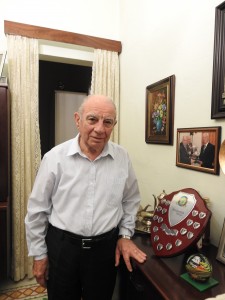 “Ageing should not be a barrier in life but a further opportunity to excel,” insists 80-year-old Angelo Zahra who has recently been selected to receive the main prize in the award ‘Premju Anzjanità Attiva’ (Award for the Active Ageing) for his voluntary management of three homes for the disabled.
“Ageing should not be a barrier in life but a further opportunity to excel,” insists 80-year-old Angelo Zahra who has recently been selected to receive the main prize in the award ‘Premju Anzjanità Attiva’ (Award for the Active Ageing) for his voluntary management of three homes for the disabled.Zahra studied mechanical engineering at the Dockyard Technical College and for several years, he served in managerial roles. Before his retirement, at age 63, he was the Director of the Manufacturing and Services Department with the Government of Malta.
“I have known Fr Angelo Seychell since his priesthood and I have always admired his work. When he founded the Nazareth Foundation in 1995 and opened his house to provide a home for people with special needs, I supported his venture by collecting donations from my colleagues twice a year. However, I was not directly involved with Dar Nazareth.”
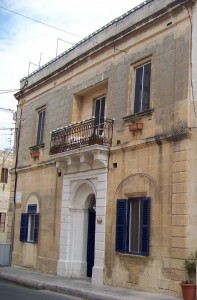 Yet Fr Seychell had for long earmarked Zahra to help him develop his mission to create a warm family environment in which people with disabilities could lead a good and respectful life which gave them the possibility to be happy and to achieve their full potential.
Yet Fr Seychell had for long earmarked Zahra to help him develop his mission to create a warm family environment in which people with disabilities could lead a good and respectful life which gave them the possibility to be happy and to achieve their full potential.“As soon as I retired, Fr Seychell approached me and asked me to consider serving as the administrator of Dar Nazareth. I accepted on condition to start three months later since I had promised my wife that I would finally take a much-awaited break from work. In the meantime, my wife and I booked a tour to Lourdes and to our great surprise we found out that the group which we were going to travel with were none other than Fr Seychell, his volunteers and the residents at Dar Nazareth. This was a golden opportunity to get to know everyone better and soon, I was deeply involved with the Nazareth Foundation.”
 “In September 2000, when I joined in, there were only five residents at Dar Nazareth. However, in a short time, the house was elaborated to receive a further five residents where it reached its full capacity. A year later, the Foundation rented a workshop wherein our residents could attend daily to entertain themselves and to make crafts which could be sold to the public.”
“In September 2000, when I joined in, there were only five residents at Dar Nazareth. However, in a short time, the house was elaborated to receive a further five residents where it reached its full capacity. A year later, the Foundation rented a workshop wherein our residents could attend daily to entertain themselves and to make crafts which could be sold to the public.”Dar Nazareth addressed a demand which had been stalled for several years. Soon, its success lead to the establishment of two other houses.
“In 2004, the Foundation opened the second house, Dar l-Arċipriet Degabriele, which welcomed a further nine residents. Five years later, the third house, Dar Jean Vanier, opened its doors to another nine residents.”
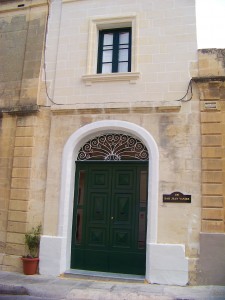 While in the beginning Dar Nazareth was operated by volunteers, the increase in residents and houses required the engagement of full-time workers.
While in the beginning Dar Nazareth was operated by volunteers, the increase in residents and houses required the engagement of full-time workers.“The funding of such projects is always one of the major stumbling blocks. The Foundation had succeeded to purchase two properties and develop them into residential homes. It also managed to acquire enough money to fund the salary of 30 full-time workers. Nevertheless, the sourcing of further income to sustain all the expenses required to keep these three homes functioning are a constant responsibility. Thankfully, in 2016, the Government signed an agreement with Nazareth Foundation through which it was given 1.4 million euro over a period of three years. This serves as a safety net for the Foundation’s administration to provide the best service possible to its residents.”
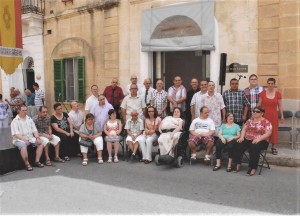 For the past 17 years, Zahra has voluntarily taken in hand the management of these three homes and presently he also acts as President of the Nazareth Foundation Board.
For the past 17 years, Zahra has voluntarily taken in hand the management of these three homes and presently he also acts as President of the Nazareth Foundation Board.“This work has become my mission to do something worthwhile with my available time. It gives me utter satisfaction to see our residents living in a friendly and family environment where they can feel safe, at ease, and loved. Their appreciation and happiness in return give me a sense of fulfilment and help me to feel much younger.”
(This feature was published in SENIOR TIMES – DECEMBER 2017 issued with The Times of Malta)
-
IBGĦATHIELI BIL-POSTA
 “Il-Milied ta’ dari kien inqas kummerċjali minn dak ta’ llum u dan huwa saħansitra evidenti minn dak li tirċievi fil-posta,” għarrafni missieri Saviour Busuttil li qatta’ 37 sena jaħdem bħala pustier.
“Il-Milied ta’ dari kien inqas kummerċjali minn dak ta’ llum u dan huwa saħansitra evidenti minn dak li tirċievi fil-posta,” għarrafni missieri Saviour Busuttil li qatta’ 37 sena jaħdem bħala pustier.Infatti f’dawn l-aħħar snin, hekk kif jibda joqrob il-Milied, il-kaxxi tal-posta tagħna jintlew b’għadd ta’ rivisti u riklami, b’kompetizzjoni bejniethom biex iħajjruk tixtri l-prodotti tagħhom. Ftit li xejn għadna nirċievu kartolini tal-Milied mingħand qrabatna u ħbiebna. Ġeneralment illum dawn l-awguri jaslu bil-fomm, bit-telefon, b’xi email jew b’xi sms fuq il-mobile.
“Sa ftit tas-snin ilu kont għadni nibgħat il-kartolini tal-Milied lill-ġenituri tiegħi u lil ħuti kollha, avolja ħafna minnhom kienu joqogħdu viċin tiegħi. U naturalment jien ukoll kont nirċievi kartolina tal-Milied mingħand kull wieħed u waħda minnhom. Hekk kienet titlob l-użanza. Għaldaqstant tista’ timmaġina l-volum kbir ta’ posta li kien jinħoloq fi żmien il-Milied.”
“Konna nkunu mifqugħin bix-xogħol, tant li wara li konna noħorġu nqassmu l-ittri matul il-ġurnata u nistrieħu ftit id-dar, konna nidħlu lura x-xogħol biex nissortjaw l-ittri. Ġieli domna sad-9.00pm għaddejjin sabiex insibu x-xogħol lest biex jitqassam għall-għada fil-għodu. Żmien il-Milied kien l-uniku perjodu li konna naħdmu l-overtime fih.”
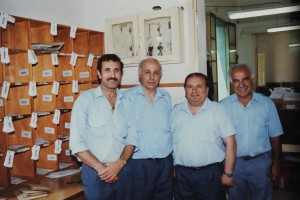 “Biex inlaħħqu mal-kwantità tal-posta, fi żmien il-Milied konna noħorġu nqassmu mat-8.00am. Konna nippakkjaw il-barżakki tagħna sa ruħ ommhom u nerħulha nduru mat-triqat dar dar. Minbarra l-ittri konna nqassmu anki xi pakketti iżda f’każ li l-pakketti jkunu kbar wisq, konna nħallu avviż ħalli dak li jkun imur jiġborhom mill-uffiċċju tal-Posta.”
“Biex inlaħħqu mal-kwantità tal-posta, fi żmien il-Milied konna noħorġu nqassmu mat-8.00am. Konna nippakkjaw il-barżakki tagħna sa ruħ ommhom u nerħulha nduru mat-triqat dar dar. Minbarra l-ittri konna nqassmu anki xi pakketti iżda f’każ li l-pakketti jkunu kbar wisq, konna nħallu avviż ħalli dak li jkun imur jiġborhom mill-uffiċċju tal-Posta.”“Matul il-bqija tas-sena, is-servizz tal-Posta kien jagħti garanzija li ittra li tintbagħat qabel is-7.00am kienet tasal għand ir-riċevitur dakinhar stess. Dan kien impossibbli li tiggarantih fi żmien il-Milied għalkemm konna nagħmlu ħilitna kollha biex il-posta tasal malajr kemm jista’ jkun. Konna nkunu konxji li ħafna kienu jkunu qed jistennewna bil-ħerqa. Sa 40 sena ilu, mhux kulħadd kellu telefon id-dar u l-posta kienet l-uniku mezz ta’ komunikazzjoni. Ngħidu aħna fost l-ittri ġieli kien ikun hemm noti tan-namrati li kienu jiktbu lil xulxin biex jifthemu fejn u fi x’ħin se jiltaqgħu. Mur fehmielhom din liż-żgħażagħ illum!”
“Meta l-internet kien għadu ineżistenti, kollox bil-posta kien jasal u għalhekk in-nies kellhom ċerta relazzjoni ta’ ħbiberija mal-pustier. Hekk kif induru l-kantuniera konna ndoqqu l-qanpiena tar-rota ħalli n-nies jindunaw li wasalna. Imma kien ikun hemm ukoll min ikun qed jistenniena fil-bieb tad-dar tiegħu. Fil-Milied in-nies kienu jilqgħuna b’mod speċjali u jpattulna tas-servizz li konna nagħtuhom matul is-sena kollha. Ħafna kienu jippreparawlna xi grokk u jekk ma noqogħdux attenti, nispiċċaw immorru kuljum fis-sakra d-dar! Kien hemm min jagħtina wkoll xi ħaġa tal-flus u konna ndabbruha tajjeb f’dawk il-ġranet. Kont tħossok apprezzat u allura x-xogħol kien jagħtik aktar sodisfazzjon.”
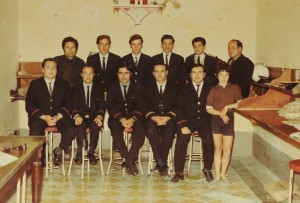 “Illum ċerti affarijiet inbidlu qatiegħ. Il-mezzi ta’ komunikazzjoni żdiedu u allura l-funzjoni tal-Posta ma baqgħetx daqshekk assoluta. Ħafna nies illum jaħdmu, inkluż in-nisa, u allura ssib inqas nies fid-djar filgħodu. Hemm ukoll il-fatt li llum meta jiżżewwġu ‘l ulied mhux neċessarjament qed jibqgħu joqogħdu fl-istess raħal jew belt fejn twieldu. Dan qed ninnutah fiż-Żejtun hekk kif m’għadux jikber bl-istess rata ta’ qabel. Inbidel ukoll it-tip ta’ bini u allura fejn dari il-pustier kien iħabbat bieb, bieb, dar, dar, illum jidħol ġol-entrata ta’ blokk ta’ appartamenti u jħalli l-ittri ġol-kaxxi mingħajr forsi qatt ma jara lir-riċevituri. B’hekk jista’ jkun li r-relazzjoni tan-nies mal-pustier ma baqgħetx li kienet. Madanakollu, jien li niftakar żminijiet oħra, għadni nilqa’ l-pustiera d-dar u ġieli noqgħod nitħaddet magħhom. Fi żmien il-Milied, kif ħaddieħor kien jagħmel miegħi, nagħtihom dik ix-xi ħaġa żgħira wkoll.”
“Illum ċerti affarijiet inbidlu qatiegħ. Il-mezzi ta’ komunikazzjoni żdiedu u allura l-funzjoni tal-Posta ma baqgħetx daqshekk assoluta. Ħafna nies illum jaħdmu, inkluż in-nisa, u allura ssib inqas nies fid-djar filgħodu. Hemm ukoll il-fatt li llum meta jiżżewwġu ‘l ulied mhux neċessarjament qed jibqgħu joqogħdu fl-istess raħal jew belt fejn twieldu. Dan qed ninnutah fiż-Żejtun hekk kif m’għadux jikber bl-istess rata ta’ qabel. Inbidel ukoll it-tip ta’ bini u allura fejn dari il-pustier kien iħabbat bieb, bieb, dar, dar, illum jidħol ġol-entrata ta’ blokk ta’ appartamenti u jħalli l-ittri ġol-kaxxi mingħajr forsi qatt ma jara lir-riċevituri. B’hekk jista’ jkun li r-relazzjoni tan-nies mal-pustier ma baqgħetx li kienet. Madanakollu, jien li niftakar żminijiet oħra, għadni nilqa’ l-pustiera d-dar u ġieli noqgħod nitħaddet magħhom. Fi żmien il-Milied, kif ħaddieħor kien jagħmel miegħi, nagħtihom dik ix-xi ħaġa żgħira wkoll.”Missieri daħal jaħdem bħala pustier meta kellu 18 il-sena.
“Iz-ziju Ċikku kien jaqra l-gazzetti kuljum u kien hu li qalli li kienu fetħu l-applikazzjonijiet għall-pustiera ġodda. Ta’ 16 il-sena temmejt l-edukazzjoni tiegħi u bħal għadd ta’ nies oħra spiċċajt nirreġistra. Kien ikun hemm ringieli sħaħ ta’ mijiet ta’ nies jirreġistraw għax ma tantx kien hemm xogħol. Biex tilħaq pustier kien ikollok toqgħod għall-eżamijiet bil-miktub fil-Matematika, l-Ingliż u l-Ġografija u ridt tiġi minn ta’ quddiem. Meta dħalt jien kienu applikaw madwar 170 u għażlu 50.”
 “Dħalt naħdem fl-uffiċċju tal-Posta taż-Żejtun li dak iż-żmien kien ikopri wkoll lil Ħal-Għaxaq, il-Gudja, Marsaxlokk u Birżebbuġa. L-ewwel ħmistax kont tqattagħhom titgħallem ir-rotta li tkun ġiet assenjata lilek. Kont tmur issegwi pustier ieħor ħalli tara kif jaħdem. F’dawk il-ġranet kont mistenni titgħallem l-ismijiet tat-toroq u tkun taf fejn huma d-djar. Jien ma kelli l-ebda problema f’dan il-qasam peress li minn tfuliti kont nixtieq insir pustier. Kont affaxxinat bit-toroq u bl-ismijiet tagħhom u għalhekk kont diġà qbadt nitgħallimhom bl-amment. Imma xorta waħda kien hemm triqat jew sqaqien fiż-Żejtun li ssorprendewni għax qatt ma kont dħalt fihom qabel. Aktar il-quddiem imbagħad kelli l-opportunità li nsir naf it-triqat ta’ partijiet ta’ Ħal-Għaxaq u tal-Gudja peress li kont inqassam hemm ukoll.”
“Dħalt naħdem fl-uffiċċju tal-Posta taż-Żejtun li dak iż-żmien kien ikopri wkoll lil Ħal-Għaxaq, il-Gudja, Marsaxlokk u Birżebbuġa. L-ewwel ħmistax kont tqattagħhom titgħallem ir-rotta li tkun ġiet assenjata lilek. Kont tmur issegwi pustier ieħor ħalli tara kif jaħdem. F’dawk il-ġranet kont mistenni titgħallem l-ismijiet tat-toroq u tkun taf fejn huma d-djar. Jien ma kelli l-ebda problema f’dan il-qasam peress li minn tfuliti kont nixtieq insir pustier. Kont affaxxinat bit-toroq u bl-ismijiet tagħhom u għalhekk kont diġà qbadt nitgħallimhom bl-amment. Imma xorta waħda kien hemm triqat jew sqaqien fiż-Żejtun li ssorprendewni għax qatt ma kont dħalt fihom qabel. Aktar il-quddiem imbagħad kelli l-opportunità li nsir naf it-triqat ta’ partijiet ta’ Ħal-Għaxaq u tal-Gudja peress li kont inqassam hemm ukoll.”“Ix-xogħol mill-ewwel għoġobni. Toqgħod iddur fit-toroq u l-isqaqien u tgħid ara das-sqaq qatt ma rajtu qabel! U n-nies kienu dħulin. Kienu jħobbuna ħafna u jafdaw ħafna fina. Uħud meta jirċievu xi ittra kienu jistaqsuni ‘Ta’ x’hiex inhi?’ U ngħidilhom tal-income tax jew tal-Awstralja per eżempju. Kif ngħidilhom tal-Awstralja kien ikun hemm min jistaqsini mingħand min għax kien ikollhom ħafna tfal hemm. U ġieli kien hemm min kien idaħħalni d-dar, jagħmilli belgħa tè, jpoġġi miegħi mal-mejda u joqgħod jismagħni naqralu l-ittra.”
“Fil-bidu pustier ġdid ma kienx ikollu r-rotta tiegħu imma kien iservi bħala sostitut sabiex jagħmel tajjeb għal meta pustiera oħra jkollhom bżonn jieħdu l-leave jew ikunu ma jifilħux. Iż-Żejtun kien maqsum f’erbgħa sezzjonijiet u ftit ftit kont tasal sakemm titgħallem ir-rotot kollha. Wara 5 snin kont tieqaf tissostitwixxi u jkollok ir-rotta tiegħek.”
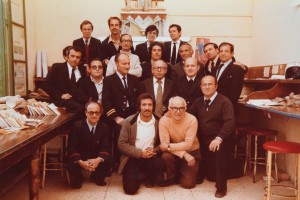 “Ix-xogħol ta’ pustier kien jinkludi li jinġabru l-ittri mill-kaxxi tal-ittri pubbliċi kollha taż-Żejtun, il-Gudja, Marsaxlokk u Birżebbuġa fis-7.00am u jittieħdu l-uffiċċju. Imbagħad l-ittri kollha kienu jitqassmu skont id-distrett tagħhom. Dawk l-ittri li kienu se jitqassmu mill-Posta taż-Żejtun kienu jinżammu filwaqt li l-oħrajn kienu jintbagħtu ma’ vann li jiġi jiġborhom biex jeħodhom fl-uffiċċju prinċipali tal-Belt. L-ittri li jinżammu kienu jiġu rranġati skont ir-rotot u kif inlestu noħorġu nqassmuhom fid-djar. Kollox kellu jitqassam dakinhar stess u kif tlesti stajt tmur lejn id-dar. Min kien imur idur bil-mixi u min bir-rota u għal dawk ir-residenti li kienu joqogħdu fl-imbiegħed, bħall-inħawi tal-bajja ta’ San Tumas u Ħal-Far, il-pustier kien imur bil-mutur. Għal xi l-10.00am kien jasal vann ieħor mill-Belt li kien iġib il-posta li jkunu rċevew l-uffiċċji tal-posta l-oħra.”
“Ix-xogħol ta’ pustier kien jinkludi li jinġabru l-ittri mill-kaxxi tal-ittri pubbliċi kollha taż-Żejtun, il-Gudja, Marsaxlokk u Birżebbuġa fis-7.00am u jittieħdu l-uffiċċju. Imbagħad l-ittri kollha kienu jitqassmu skont id-distrett tagħhom. Dawk l-ittri li kienu se jitqassmu mill-Posta taż-Żejtun kienu jinżammu filwaqt li l-oħrajn kienu jintbagħtu ma’ vann li jiġi jiġborhom biex jeħodhom fl-uffiċċju prinċipali tal-Belt. L-ittri li jinżammu kienu jiġu rranġati skont ir-rotot u kif inlestu noħorġu nqassmuhom fid-djar. Kollox kellu jitqassam dakinhar stess u kif tlesti stajt tmur lejn id-dar. Min kien imur idur bil-mixi u min bir-rota u għal dawk ir-residenti li kienu joqogħdu fl-imbiegħed, bħall-inħawi tal-bajja ta’ San Tumas u Ħal-Far, il-pustier kien imur bil-mutur. Għal xi l-10.00am kien jasal vann ieħor mill-Belt li kien iġib il-posta li jkunu rċevew l-uffiċċji tal-posta l-oħra.”“Qattgħajt 22 sena niġri bir-rota u nqassam l-ittri. Bħal kull xogħol hemm is-sabiħ u l-ikraħ tiegħu. Fis-sajf kont tbati mis-sħana u mill-qilla tax-xemx imma fix-xitwa kien wisq agħar għax kont tixxarrab jekk ikun il-maltemp u tirriskja li tlaqqgħat xi riħ. Kien hemm ukoll problema bil-klieb tan-nies li ġieli kienu jħebbu għalik kif jarawk riesaq. Darba minnhom gidimni kelb u ċarratli l-qalziet tal-uniformi.”
“Wara 22 sena ngħatajt promozzjoni u lħaqt Mail Officer u xogħoli kien fuq ġewwa biss. Meta għaddew 10 snin oħra lħaqt Mail Inspector u hemm ġejt responsabbli mill-uffiċċju tal-Posta taż-Żejtun. Matul is-snin rajt diversi żviluppi jseħħu fosthom l-introduzzjoni ta’ pustiera nisa li qabel kienu jiġu evitati biex ma jkunx hemm taħlit bejn nisa u rġiel. Finalment ta’ 55 sena ħriġt bil-pensjoni.”
 Illum missieri jgħodd is-70 sena iżda għalkemm għaddew 15 il-sena minn mindu waqaf mix-xogħol, għadu jiftakar ċar l-ismijiet kollha tat-triqat tal-inħawi li ħadem fihom, in-numri tad-djar u saħansitra l-kunjomijiet tas-sidien tagħhom ukoll.
Illum missieri jgħodd is-70 sena iżda għalkemm għaddew 15 il-sena minn mindu waqaf mix-xogħol, għadu jiftakar ċar l-ismijiet kollha tat-triqat tal-inħawi li ħadem fihom, in-numri tad-djar u saħansitra l-kunjomijiet tas-sidien tagħhom ukoll.“Sal-bieraħ iltqajt ma’ waħda ġo ħanut li kellha madwar 40 sena. X’ħin ratni qaltli ‘Tiftakar kemm kont tagħtina posta?’ Għall-ewwel m’għarafthiex imma meta semmietli t-triq fejn kienet toqgħod, stajt ngħidilha n-numru tal-bieb tagħhom u l-kunjom tal-familja. Stagħġbet li kont għadni niftakar wara tant snin!”
Meta tkun qattgħajt daqstant żmien taħdem bħala pustier diffiċli tinsa l-informazzjoni kollha li tkun immemorizzajt. Missieri jistqarr li kultant għadu joħlom li qiegħed idur bir-rota madwar it-toroq iqassam l-ittri lin-nies.
(Dan l-artiklu ġie ppubblikat fis-suppliment Senior Times li ħareġ mal-ġurnal The Times of Malta tal-15 ta’ Diċembru 2017)
-
MAN ON A MISSION
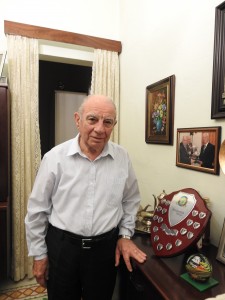 “Ageing should not be a barrier in life but a further opportunity to excel,” insists 80-year-old Angelo Zahra who has recently been selected to receive the main prize in the award ‘Premju Anzjanità Attiva’ (Award for the Active Ageing) for his voluntary management of three homes for the disabled.
“Ageing should not be a barrier in life but a further opportunity to excel,” insists 80-year-old Angelo Zahra who has recently been selected to receive the main prize in the award ‘Premju Anzjanità Attiva’ (Award for the Active Ageing) for his voluntary management of three homes for the disabled.Zahra studied mechanical engineering at the Dockyard Technical College and for several years, he served in managerial roles. Before his retirement, at age 63, he was the Director of the Manufacturing and Services Department with the Government of Malta.
“I have known Fr Angelo Seychell since his priesthood and I have always admired his work. When he founded the Nazareth Foundation in 1995 and opened his house to provide a home for people with special needs, I supported his venture by collecting donations from my colleagues twice a year. However, I was not directly involved with Dar Nazareth.”
 Yet Fr Seychell had for long earmarked Zahra to help him develop his mission to create a warm family environment in which people with disabilities could lead a good and respectful life which gave them the possibility to be happy and to achieve their full potential.
Yet Fr Seychell had for long earmarked Zahra to help him develop his mission to create a warm family environment in which people with disabilities could lead a good and respectful life which gave them the possibility to be happy and to achieve their full potential.“As soon as I retired, Fr Seychell approached me and asked me to consider serving as the administrator of Dar Nazareth. I accepted on condition to start three months later since I had promised my wife that I would finally take a much-awaited break from work. In the meantime, my wife and I booked a tour to Lourdes and to our great surprise we found out that the group which we were going to travel with were none other than Fr Seychell, his volunteers and the residents at Dar Nazareth. This was a golden opportunity to get to know everyone better and soon, I was deeply involved with the Nazareth Foundation.”
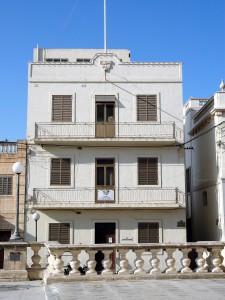 “In September 2000, when I joined in, there were only five residents at Dar Nazareth. However, in a short time, the house was elaborated to receive a further five residents where it reached its full capacity. A year later, the Foundation rented a workshop wherein our residents could attend daily to entertain themselves and to make crafts which could be sold to the public.”
“In September 2000, when I joined in, there were only five residents at Dar Nazareth. However, in a short time, the house was elaborated to receive a further five residents where it reached its full capacity. A year later, the Foundation rented a workshop wherein our residents could attend daily to entertain themselves and to make crafts which could be sold to the public.”Dar Nazareth addressed a demand which had been stalled for several years. Soon, its success lead to the establishment of two other houses.
“In 2004, the Foundation opened the second house, Dar l-Arċipriet Degabriele, which welcomed a further nine residents. Five years later, the third house, Dar Jean Vanier, opened its doors to another nine residents.”
While in the beginning Dar Nazareth was operated by volunteers, the increase in residents and houses required the engagement of full-time workers.
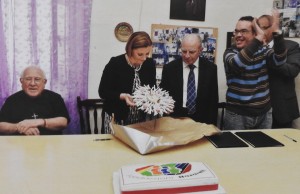 “The funding of such projects is always one of the major stumbling blocks. The Foundation had succeeded to purchase two properties and develop them into residential homes. It also managed to acquire enough money to fund the salary of 30 full-time workers. Nevertheless, the sourcing of further income to sustain all the expenses required to keep these three homes functioning are a constant responsibility. Thankfully, in 2016, the Government signed an agreement with Nazareth Foundation through which it was given 1.4 million euro over a period of three years. This serves as a safety net for the Foundation’s administration to provide the best service possible to its residents.”
“The funding of such projects is always one of the major stumbling blocks. The Foundation had succeeded to purchase two properties and develop them into residential homes. It also managed to acquire enough money to fund the salary of 30 full-time workers. Nevertheless, the sourcing of further income to sustain all the expenses required to keep these three homes functioning are a constant responsibility. Thankfully, in 2016, the Government signed an agreement with Nazareth Foundation through which it was given 1.4 million euro over a period of three years. This serves as a safety net for the Foundation’s administration to provide the best service possible to its residents.”For the past 17 years, Zahra has voluntarily taken in hand the management of these three homes and presently he also acts as President of the Nazareth Foundation Board.
 “This work has become my mission to do something worthwhile with my available time. It gives me utter satisfaction to see our residents living in a friendly and family environment where they can feel safe, at ease, and loved. Their appreciation and happiness in return give me a sense of fulfilment and help me to feel much younger.”
“This work has become my mission to do something worthwhile with my available time. It gives me utter satisfaction to see our residents living in a friendly and family environment where they can feel safe, at ease, and loved. Their appreciation and happiness in return give me a sense of fulfilment and help me to feel much younger.”(This feature was published in the Senior Times supplement issued with The Times of Malta on 15 December 2017)
-
LIGHTS OUT FOR CHRISTMAS
Christmas time and the days preceding it are generally associated with colour, light, optimism and fun. Yet this was not the case in 1939 when the Christmas season became synonymous with gloom, darkness, uncertainty and fear.
On 18 September 1939, a table showing the duration of the ‘Official Night’ was published in Government Notice No. 459 in The Malta Government Gazette. This table included each day of each month and the beginning and end of what was to be considered as the official night hours. Such instructions formed part of the Malta Defence Regulations, 1939, which aimed to protect the Maltese Islands and its inhabitants as World War II ravaged in other countries.
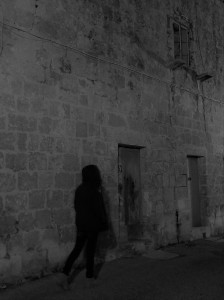 Two days later, on 20 September 1939, Government Notice No. 473 issued the Lights Restriction Order which was effective from that day. The directions of this Order had to be observed between midnight and 4:30am on every day of the week, and also between 10:00pm and midnight on Fridays. During these times, all lights in any building had to be masked to be invisible from the sea and from the air. No lights, other than lights authorised by the competent authority, were permitted in any open spaces whether private or public, in yards, roofs or open verandas. The use of illuminated lettering or signs in any shops were prohibited unless authorised by the Commissioner of Police or the competent authority. The traffic of motor vehicles during these hours was banned and any vehicles which did not comply with these provisions could be stopped and detained until 6:00am. Obviously, all fireworks were also prohibited.
Two days later, on 20 September 1939, Government Notice No. 473 issued the Lights Restriction Order which was effective from that day. The directions of this Order had to be observed between midnight and 4:30am on every day of the week, and also between 10:00pm and midnight on Fridays. During these times, all lights in any building had to be masked to be invisible from the sea and from the air. No lights, other than lights authorised by the competent authority, were permitted in any open spaces whether private or public, in yards, roofs or open verandas. The use of illuminated lettering or signs in any shops were prohibited unless authorised by the Commissioner of Police or the competent authority. The traffic of motor vehicles during these hours was banned and any vehicles which did not comply with these provisions could be stopped and detained until 6:00am. Obviously, all fireworks were also prohibited.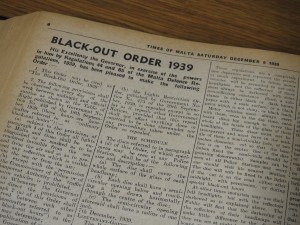 An Air-Raid Precautions Order was communicated in Government Notice No. 504 on 4 October 1939. Eventually on 9 December 1939, The Times of Malta published the provisions of The Black-Out Order, 1939, which had to be observed on every day of the week between midnight and the official sunrise. During these hours, all the lights on the Islands had to be extinguished or masked as to be rendered invisible from the sea and from the air. Special Black-Out hours could also be determined when necessary.
An Air-Raid Precautions Order was communicated in Government Notice No. 504 on 4 October 1939. Eventually on 9 December 1939, The Times of Malta published the provisions of The Black-Out Order, 1939, which had to be observed on every day of the week between midnight and the official sunrise. During these hours, all the lights on the Islands had to be extinguished or masked as to be rendered invisible from the sea and from the air. Special Black-Out hours could also be determined when necessary. As part of the Black-Out Order, from 14 December 1939, all motor vehicles which had to travel at night, other than those belonging to His Majesty’s service, had to have their bulbs removed from their lamps. Opaque cardboard discs were to be fixed to the lights of the vehicles and the reflectors’ surface had to be covered with a non-reflecting substance. A white disc had to be affixed at the back of all motor vehicles at a height of three feet from the ground to make them visible on the roads. Traffic of motor vehicles during the black-out was prohibited except for those who obtained permission from the Commissioner of Police or a competent authority.
Another notice which appeared on The Times of Malta of the 9 December 1939 urged the inhabitants to comply with these regulations for their own safety. People were recommended to stay at home and to avoid going out in the darkness. Those who needed to get out were advised to walk on the right-hand side of the road to face oncoming traffic and to carry with them a white object to make them more visible to drivers. Owners of goats were informed to keep their animals off the road at night. On the other hand, drivers were cautioned to drive very slowly and with great care.
Measures were being taken to prepare the people how to take the necessary precautions in preparation of an expected war. Black-outs intended to prevent crews of enemy aircraft from being able to identify their targets by sight. Nonetheless, these precautionary provisions proved to be one of the more unpleasant aspects of war, disrupting many civilian activities and causing widespread grumbling and lower morale.
The Times of Malta of 13 December 1939 reports that some misapprehension had arisen among that section of the public who had to rise early for work and travel by early buses, since it was not clear at what time the bus service started. Indeed, all buses were to continue their usual service provided that they adhered to the regulations regarding headlights and lights, including the inside of the vehicles which had to remain in darkness.
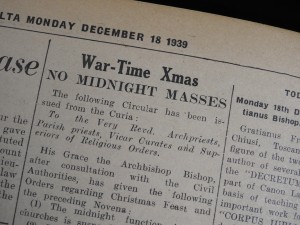 Even though the Maltese Islands were not yet directly involved in war, a foreboding atmosphere crept its way into the lives of people. As if matters were not yet miserable enough, a Bishop’s Circular which was published on The Times of Malta of 17 December 1939 declared that the Christmas midnight function in the churches was to be suspended. The Novena and feast functions could be celebrated from 4:00am onwards provided that no lights were visible from the outside. Those churches which required singers and musicians from far places for the early Christmas function had to apply to the Commissioner of Police for the necessary permits to travel. While it was permissible to give a small sign to the faithful by the ringing of bells for the function of the Novena and Christmas Eve, this had to be done according to predetermined rules.
Even though the Maltese Islands were not yet directly involved in war, a foreboding atmosphere crept its way into the lives of people. As if matters were not yet miserable enough, a Bishop’s Circular which was published on The Times of Malta of 17 December 1939 declared that the Christmas midnight function in the churches was to be suspended. The Novena and feast functions could be celebrated from 4:00am onwards provided that no lights were visible from the outside. Those churches which required singers and musicians from far places for the early Christmas function had to apply to the Commissioner of Police for the necessary permits to travel. While it was permissible to give a small sign to the faithful by the ringing of bells for the function of the Novena and Christmas Eve, this had to be done according to predetermined rules.Albeit the continuous warnings and pleas to adhere strictly to the black-out orders, it seemed that not everyone was following the rules. An announcement on The Times of Malta of the 20 December 1939 issued by the Lieutenant’s Government Office advised the public that the black-out on the night of December 15-16 was not entirely satisfactory, and that there were several lights showing in the Valletta, Sliema, Hamrun, Cospicua and Naxxar districts. Several lights were only put out as aircraft passed overhead. This notice pointed out also that a section of the public could still have been unaware of the black-out rules since they seemed to have been published only on The Times of Malta and Il-Berqa newspapers. Illiterate persons would therefore have had no way of being forewarned except by hearsay. Therefore, a siren warning which was different from the Air-Raid alarm signal, was recommended to be given throughout the islands at sunset.
Letters by readers in the Correspondence section of The Times of Malta of the 20 and 21 December 1939 vent their frustration and contempt at those who were not taking these black-out precautions seriously:
“Many people rather irresponsibly remark that they do not quite see the use of strict black-outs when Germany is at such a distance away. The reply is that precaution is better than cure. I am sure that these people will think very different if they find one day a German bomb dropping at their door-step or in their backyard, just because some stray lights guided an enemy to an objective.” Signed ‘Common-Sense’.
“I am sure that a number of law-abiding citizens in these islands feel that the time has come for coercion to replace coaxing. Those people who scorn to comply with reasonable regulations are either knaves or fools and most dangerous to the community in war time; they should be under lock and key for the duration of the war: either in jail or in a lunatic asylum. The pathetic appeals made by the authorities are becoming nauseating.” Signed Lieutenant Colonel (retired) H. M Marshall.
 Special Black-Out arrangements for Christmas and New Year, published on The Times of Malta of the 23 and 30 December 1939, informed the public that the black-out of buildings on the nights of 24 – 27 December and 30 December – 1 January were to be postponed for one and a half hours from midnight. On these nights, motor vehicles were allowed on the road without requiring special permission until 1:30am, and shops and places of entertainment could remain open until 1:00am.
Special Black-Out arrangements for Christmas and New Year, published on The Times of Malta of the 23 and 30 December 1939, informed the public that the black-out of buildings on the nights of 24 – 27 December and 30 December – 1 January were to be postponed for one and a half hours from midnight. On these nights, motor vehicles were allowed on the road without requiring special permission until 1:30am, and shops and places of entertainment could remain open until 1:00am.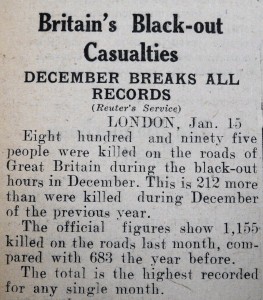 Possibly few had considered that light could be their enemy until it became essential to extinguish it. There was no mention of accidents or fatalities due to the black-out on the Islands in the December’s Times of Malta newspapers. However, reports from Great Britain relating to the high increase in road fatalities during the night were quite shocking. On 13 December 1939, the British Official Press stated that road fatalities had increased considerably from September to November. Yet the worst scenario took place in December, as reported by the Reuter’s Service on 16 January 1940, when 895 people were killed on the roads of Great Britain during the black-out hours. This was 212 more than those who were killed during December of the previous year.
Possibly few had considered that light could be their enemy until it became essential to extinguish it. There was no mention of accidents or fatalities due to the black-out on the Islands in the December’s Times of Malta newspapers. However, reports from Great Britain relating to the high increase in road fatalities during the night were quite shocking. On 13 December 1939, the British Official Press stated that road fatalities had increased considerably from September to November. Yet the worst scenario took place in December, as reported by the Reuter’s Service on 16 January 1940, when 895 people were killed on the roads of Great Britain during the black-out hours. This was 212 more than those who were killed during December of the previous year.This was surely a strange Christmas to the Maltese people who are accustomed to celebrate these days in a profuse way. Although through no fault of their own, they were involved in war and they had to adapt to war conditions. Alas, much worse was yet to come.
(This article was published in the Christmas Times magazine issued with The Times of Malta dated 13 December 2017)
-
Long shell life
 Although during the Christmas season, it is customary to see statues of baby Jesus in a manger or in a crib, in Candice Fava’s shop New EGGsperience, the holy child would be seen resting in a decorated eggshell.
Although during the Christmas season, it is customary to see statues of baby Jesus in a manger or in a crib, in Candice Fava’s shop New EGGsperience, the holy child would be seen resting in a decorated eggshell.“I love to create unique hand-made objects and this craft of eggshell decoration has provided me with the opportunity to have my own niche market,” Fava explains.
Fava was raised on a farm in Australia, where her family sold eggs. They had several clients but one particular client intrigued Fava since she regularly purchased a substantial quantity of eggs.
“One day I decided to ask her why she always needed so many eggs and she promised that the next time she called at our farm, she would bring me a gift to show me. I felt deeply curious and I awaited her next visit with much anticipation. Eventually, she brought me a little jewel box adorned with lovely fabrics and accessories. I could not believe that she had actually made it with one of the eggs from our farm!”
 Fava was so fascinated with this idea that she decided to learn this craft. At the farm, she had all the eggs that she required and in time she learnt how to clean them without breaking them. Soon, she was producing her own eggshell decorations.
Fava was so fascinated with this idea that she decided to learn this craft. At the farm, she had all the eggs that she required and in time she learnt how to clean them without breaking them. Soon, she was producing her own eggshell decorations.“The first item I made was a jewel box which I painted with bright nail polish. I was so delighted when I saw it ready! Today I realize that it wasn’t much but it is still very dear to me as it reminds me from where it all started.”
Along the years, eggshell decoration became an integral part of Fava’s life. Which explains why she was surprised when she came over to Malta and realized that this craft was totally unknown on the island.
“It was hard at first to find the necessary materials to work with. However, my husband Ivan helped me to locate some local farms which could provide me with eggs. He also assisted me in the cleaning and sterilization of the eggshells.”
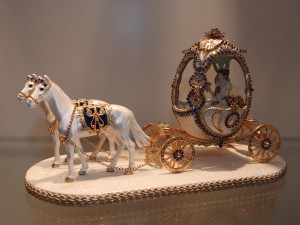 Initially she decorated eggshells for her personal enjoyment. Then she began to give them out as gifts to her friends.
Initially she decorated eggshells for her personal enjoyment. Then she began to give them out as gifts to her friends.“My friends were delighted with these eggshell decorations since they had never seen anything like them before. Soon they were asking me to make some more creations for them so that they could give them as presents to others. It was only a matter of time until I confirmed that there was a demand for such products.”
Ultimately, people’s positive reactions to her craft led her to open her own shop in Zabbar.
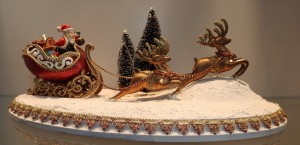 “By then, I had produced so many various eggshell decorations that I had no difficulty to fill the shop with my creations. Each time that new clients come in, it is charming to see their incredulity that so many exquisite things can be made from common fragile eggshells.”
“By then, I had produced so many various eggshell decorations that I had no difficulty to fill the shop with my creations. Each time that new clients come in, it is charming to see their incredulity that so many exquisite things can be made from common fragile eggshells.”Nowadays, the Favas have located foreign suppliers who are able to furnish them with quantities of ready-made cleaned and sterilized eggshells. Moreover, they have also managed to establish contacts with suppliers of other materials with which the eggshells are decorated.
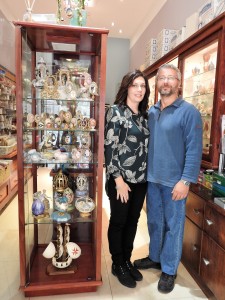 “My husband supports me a lot and helps me to come out with new ideas. Along the years, he too became enthusiastic about this work and now he is able to make his own creations.”
“My husband supports me a lot and helps me to come out with new ideas. Along the years, he too became enthusiastic about this work and now he is able to make his own creations.”A wide range of differently decorated eggshells which are ideal as gifts for various occasions are displayed at their shop. However, a few of them are not for sale.
“When we join forces, we create the best decorations,” the two agree. “The collaboration of ideas lead to exclusive objects which become difficult to part from. Some of them, such as the lamp shade, the handbag set and the sea vessel, are cherished objects and we have won prestigious awards for them at local national craft competitions. Such works provide us also with the opportunity to combine different materials and crafts like woodwork and eggshell decoration. Our imagination has no limit, however we are restrained with the eggshells’ curvatures, although we take that as part of the challenge.”
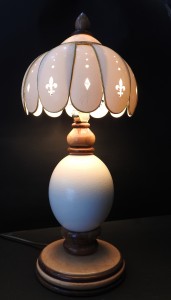 Even though all of the creations may serve as decorations, some of them also have their own practical use, acting as exotic containers, wearable accessories or light fittings.
Even though all of the creations may serve as decorations, some of them also have their own practical use, acting as exotic containers, wearable accessories or light fittings.“Besides selling our creations from my shop, I also participate in several fairs and exhibitions and therefore more people are getting to know about this craft. Presently I am also taking part in the program Niskata which airs on TVM. Yet there is still much more to do to create more awareness.”
“It is great to see how far a simple hobby can take you. Little by little, all my family has become involved in this craft. In fact, my daughter is already coming up with her own designs and creations and my little son is showing interest too.”
In these last years, Fava has also dedicated herself to teach this craft to all those who are interested, both children and adults. She has also furnished her shop with all the necessary materials including eggshells of various sizes, cut eggshells, acrylic paints, stands, bases and a multitude of other items.
As Christmas time approaches, the two explore the possibility of new designs and ideas in order to come out with original creations which relate to this theme.
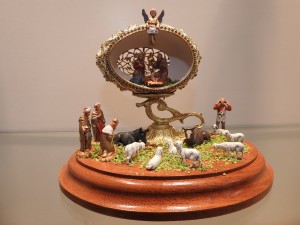 “We are always dreaming of what we are going to do next. We work with all sorts of eggshells, starting with the smallest ones of love-birds and parrots, and moving on to larger ones such as those of pigeons, quails, ducks, geese, emu, rhea and ostrich. The geese’s eggs are the most practical because of their size and shape. Other eggs are relished for their natural particular characteristics such as the blackish colour of the rhea eggs and the large shape and pearly shade of the ostrich eggs.”
“We are always dreaming of what we are going to do next. We work with all sorts of eggshells, starting with the smallest ones of love-birds and parrots, and moving on to larger ones such as those of pigeons, quails, ducks, geese, emu, rhea and ostrich. The geese’s eggs are the most practical because of their size and shape. Other eggs are relished for their natural particular characteristics such as the blackish colour of the rhea eggs and the large shape and pearly shade of the ostrich eggs.”“Christmas brings a lot of joy and memories. This festive season opens up a whole new world to create related items with baby Jesus statues, cribs, angels, Father Christmas, reindeers, sparkles and a whole range of bright colours. We love to reflect the warm meaning of Christmas in our works.”
-
KONTINENT IEĦOR
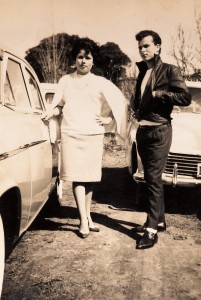 “F’żogħżiti l-Awstralja kienet meqjusa bħala dinja tal-ħolm, dinja ta’ opportunitajiet li ma kellniex f’pajjiżna. Ironikament it-tmiem tat-Tieni Gwerra Dinjija nissel problema ta’ qgħad kbir fil-gżejjer Maltin u speċjalment iż-żgħażagħ bdew jaħarquhom saqajhom biex jitilqu minn fuq din l-art ħalli jfittxu xortihom x’imkien ieħor. Jien kont waħda minn dawk iż-żgħażagħ li flimkien ma’ żewġ ħuti erħejnielha lejn dan il-kontinent b’sens qawwi ta’ avventura. Imma ġaladarba sibt ruħi hemm irrealizzajt x’kont napprezza tassew f’ħajti u dan kollu kien qiegħed f’art twelidi.”
“F’żogħżiti l-Awstralja kienet meqjusa bħala dinja tal-ħolm, dinja ta’ opportunitajiet li ma kellniex f’pajjiżna. Ironikament it-tmiem tat-Tieni Gwerra Dinjija nissel problema ta’ qgħad kbir fil-gżejjer Maltin u speċjalment iż-żgħażagħ bdew jaħarquhom saqajhom biex jitilqu minn fuq din l-art ħalli jfittxu xortihom x’imkien ieħor. Jien kont waħda minn dawk iż-żgħażagħ li flimkien ma’ żewġ ħuti erħejnielha lejn dan il-kontinent b’sens qawwi ta’ avventura. Imma ġaladarba sibt ruħi hemm irrealizzajt x’kont napprezza tassew f’ħajti u dan kollu kien qiegħed f’art twelidi.”Trabbejt nisma’ dawn ir-rakkonti t’ommi Angela Busuttil peress li spiss kienet issemmi ż-żminijiet li għexet fl-Awstralja. Barra minn hekk, minħabba li wieħed minn ħutha kien għadu jgħix hemmhekk, mhux darba u tnejn li n-nanna Fortunata Abela u z-zija Gracie Cilia talbuni biex niktbilhom xi ittra ħalli jibgħatuhielu. Niftakar li kienu ittri li kollha jibdew l-istess “Għażiż Ġużeppi, Vera u t-tfal, nispera li tinsabu tajbin bħal kif ninsabu aħna għall-grazzja t’Alla”.
Kont tgħallimt nikteb l-introduzzjoni bl-amment u kont nitbissem meta nara li dejjem kienu jiktbulu l-istess ħaġa. Il-bqija tal-ittri kienu jikkonsistu f’dak li jkunu għaddew minnu matul dawk l-aħħar ġimgħat jew dwar xi ħaġa li kienu beħsiebhom jagħmlu. Ta’ tifla li kont, ftit stajt napprezza dawk l-ittri ripetittivi. Kellhom jgħaddu ħafna snin qabel fhimt kemm kienu jfissru għalihom dawk il-karti ċelesti li kont niktbilhom l-ittri fuqhom u għaliex kienu jistennew ir-risposti tagħhom tant b’ħerqa. Ir-raġuni kienet dejjem spjegata ċara fir-rakkonti t’ommi. Imma kultant jekk ma ġġarrabx, għajnejk ma jinfetħux. Illum li jiena sirt omm u li s-snin gerrbu fuq ommi wkoll, kapaċi nixtarr aktar.
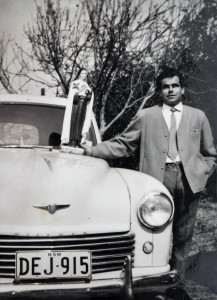 “Kien ħija l-kbir Ġużeppi li beda jħeġġiġna biex immorru l-Awstralja. Hu kien diġà miżżewweġ u kellu l-familja tiegħu. Jien kien għad kelli 17 il-sena, ommi ma riditnix immur, u missieri ma ried jagħti b’xejn il-kunsens tiegħu biex insiefer. Imma meta għalaqt it-18 il-sena, Ġużeppi rnexxielu jikkonvinċi lil missieri li kien ser jieħu ħsiebi hu. Wegħdu li ser iġib ruħu daqs li kieku kien it-tieni missier tiegħi u kelmtu żammha għax id-dixxiplina tiegħu kienet iebsa mhux ħażin!”
“Kien ħija l-kbir Ġużeppi li beda jħeġġiġna biex immorru l-Awstralja. Hu kien diġà miżżewweġ u kellu l-familja tiegħu. Jien kien għad kelli 17 il-sena, ommi ma riditnix immur, u missieri ma ried jagħti b’xejn il-kunsens tiegħu biex insiefer. Imma meta għalaqt it-18 il-sena, Ġużeppi rnexxielu jikkonvinċi lil missieri li kien ser jieħu ħsiebi hu. Wegħdu li ser iġib ruħu daqs li kieku kien it-tieni missier tiegħi u kelmtu żammha għax id-dixxiplina tiegħu kienet iebsa mhux ħażin!”“Bilkemm niftakar kif saru l-preparazzjonijiet bil-ġenn li kelli biex nitlaq. Bsart li ser nimmissja lill-ġenituri tiegħi u lil ħuti l-oħra. Imma ta’ żagħżugħa li kont neħħejt dawk il-ħsibijiet minn quddiem għajnejja u minflok intfajt noħlom dwar dik l-opportunità sabiħa li ngħix u naħdem f’pajjiż ieħor. Dakinhar li tlaqna biex nibdew dan il-vjaġġ, ommi għafsitni magħha u reġgħet qaltli li ma xtaqitnix immur. Il-ħsieb tal-firda minni kien diġà qed ikiddha iżda meta ratni konvinta biex insiefer, talbitni biex ma ninsihiex u biex ma nibqax hemm. Madanakollu jien moħħi kien biss f’dak il-vapur sabiħ li kien qed jistenniena biex jeħodna lejn l-Awstralja.”
“Għal dan il-vjaġġ konna jiena, ħija Indrì u ħija Ġużeppi bil-familja tiegħu. Morna b’vapur lussuż, l-Angelina Lauro. Il-kmamar kienu spazzjużi u komdi. Ħallasna biss Lm10 kull wieħed biex vjaġġajna għal xahar sħiħ fuqu. Kien hemm ħafna Maltin oħra u kollha konna stmati tajjeb ħafna. Il-vjaġġ kien interessanti u pjaċevoli sakemm wasalna f’Port Said fil-Baħar l-Aħmar u nqbadna f’maltemp kbir. F’daqqa waħda kollox beda jitkaxkar ‘l hawn u ‘l hemm: l-imwejjed, is-siġġijiet, is-sodod. Tal-biża’! Ħafna mill-passiġġieri kellhom jingħataw il-mediċini għax ħassewhom ma jifilħux. Lili kieku m’għamilli xejn il-baħar imma ħassejtni tterrorizzata. Wara dakinhar bosta kienu b’qalbhom imtaqtqa kif ser naslu l-Awstralja għax il-vjaġġ donnu ma ried jispiċċa qatt! Niftakar li l-klieb il-baħar baqgħu jsegwuna matul il-vjaġġ kollu, dejjem jistennew lill-ħaddiema ta’ fuq il-vapur biex jarmu l-fdalijiet tal-ikel fil-baħar.”
 “Malli wasalna Melbourne laqagħna temp imsaħħab u xejn ma ħadt grazzja mal-post. Xi ħbieb li kienu qed jistennewna ħaduna Adelaide li kien jumejn bogħod bil-karozza. Hemmhekk għamilna ftit taż-żmien. Kien post kwiet u ma tantx kien hemm xogħol. Tlaqna u morna Sydney, niġru minn xogħol għall-ieħor. Niftakar li l-ewwel darba li mort għax-xogħol, tlajt fi tren u marret għajni bija, u t-tren baqgħet sejra bija f’post ieħor. Tgħidx kemm bżajt meta stenbaħt u ma kontx naf x’se naqbad nagħmel. Tinkwieta għax la ma tkunx taf il-post, ma tafx ma’ min tista’ tiltaqa’. Ħdimt f’żewġ fabbriki imma ma nista’ ninsa qatt kemm laqgħuni b’mod sabiħ fl-ewwel fabbrika li dħalt fiha. Kont ilni naħdem hemm ftit ġranet biss u hekk kif skoprew li kont għadni kif għalaqt it-18 il-sena għamluli surprise party u tgħidx kemm tawni rigali! Lanqas wara għaxar snin xogħol ma jagħmlulek hekk f’Malta!”
“Malli wasalna Melbourne laqagħna temp imsaħħab u xejn ma ħadt grazzja mal-post. Xi ħbieb li kienu qed jistennewna ħaduna Adelaide li kien jumejn bogħod bil-karozza. Hemmhekk għamilna ftit taż-żmien. Kien post kwiet u ma tantx kien hemm xogħol. Tlaqna u morna Sydney, niġru minn xogħol għall-ieħor. Niftakar li l-ewwel darba li mort għax-xogħol, tlajt fi tren u marret għajni bija, u t-tren baqgħet sejra bija f’post ieħor. Tgħidx kemm bżajt meta stenbaħt u ma kontx naf x’se naqbad nagħmel. Tinkwieta għax la ma tkunx taf il-post, ma tafx ma’ min tista’ tiltaqa’. Ħdimt f’żewġ fabbriki imma ma nista’ ninsa qatt kemm laqgħuni b’mod sabiħ fl-ewwel fabbrika li dħalt fiha. Kont ilni naħdem hemm ftit ġranet biss u hekk kif skoprew li kont għadni kif għalaqt it-18 il-sena għamluli surprise party u tgħidx kemm tawni rigali! Lanqas wara għaxar snin xogħol ma jagħmlulek hekk f’Malta!”“L-Awstralja kienet tgħaġġibni bil-kobor tagħha. Kienet sabiħa ħafna b’siġar twal u b’għelieqi spazzjużi u b’toroq li ma jispiċċaw qatt. Ġieli rajt ukoll xi annimali tal-post, l-aktar il-kangaroos kbar li mhux darba u tnejn fettlilhom jintasbu f’nofs ta’ triq u ma jkunu jridu jwarrbu b’xejn biex ngħaddu bil-karozza. Konna noqogħdu Greenacre fejn krejna dar pjuttost kbira. Ma tantx kien hemm Maltin. Kellna familja aboriġina fost il-ġirien tagħna u t-tfal tagħhom kienu jiġu jilgħabu magħna. Madwarna kienu joqgħodu nies minn kull pajjiż.”
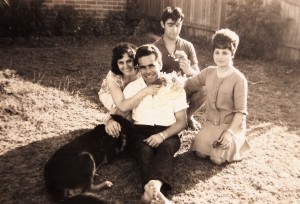 “Kien hemm okkażżjonijiet fejn konna noħorġu xi ftit. Niftakar li ġieli morna naraw ir-wrestling. Kien ikollna l-ġellied favorit tagħna u erħilna ngħajjtu kemm nifilħu meta jibda jaqla’ xi daqqtejn sew mingħand l-ieħor. Konna nidħlu b’vuċi tajba u noħorġu maħnuqin imma konna nieħdu gost. Dejjem bqajt bil-kurżità jekk kienux ikunu qed jiġġieldu veru jew le. Tant kienu jaqilgħu li ma stajtx nemmen li kienu jagħtu bis-serjetà!”
“Kien hemm okkażżjonijiet fejn konna noħorġu xi ftit. Niftakar li ġieli morna naraw ir-wrestling. Kien ikollna l-ġellied favorit tagħna u erħilna ngħajjtu kemm nifilħu meta jibda jaqla’ xi daqqtejn sew mingħand l-ieħor. Konna nidħlu b’vuċi tajba u noħorġu maħnuqin imma konna nieħdu gost. Dejjem bqajt bil-kurżità jekk kienux ikunu qed jiġġieldu veru jew le. Tant kienu jaqilgħu li ma stajtx nemmen li kienu jagħtu bis-serjetà!”“Il-kobor tal-post kien jaqtgħalna qalbna biex nimirħu ‘l bogħod. U l-biċċa l-kbira minn ħajjitna kienet iddedikata biss għax-xogħol. Agħar minn hekk, ommna spiss kienet tibgħatilna l-ittri jew xi casette irrekordjatha bil-vuċi tagħha fejn kienet twissina biex noqogħdu attenti ħalli ma nweġġgħux u b’mod speċjali, biex ma niżżewġux hemmhekk. “Fittxu ejjew ‘l hawn, ejjew lura,” kienet dejjem tirrepeti. Kemm tiflaħ tisma’ kliem bħal dan?”
“Ma domnix ma bdejna niddejqu u nixxenqu biex nirritornaw lejn pajjiżna fejn fiċ-ċokon tiegħu kellna dak kollu li ridna. Il-problema kienet li għalkemm biex morna l-Awstralja kellna nħallsu biss Lm10 kull wieħed, biex naqbdu vapur lura lejn Malta l-prezz kien Lm250 kull ras. Għamilna sentejn u nofs ngħixu hemm sakemm irnexxielna nfaddlu biżżejjed flus għalina kollha. Ġejna lura Malta bil-vapur Achille Lauro u mill-ġdid domna xahar nivvjaġġaw.”
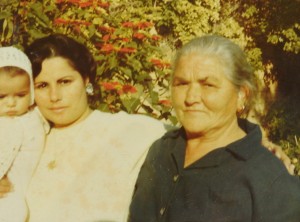 “Kont kuntenta li rajt pajjiż ieħor imma ddispjaċini ħafna li tlaqt il-familja tiegħi. Ħadt ir-ruħ hekk kif wasalna lura Malta u rajthom kollha qawwijin u sħaħ. Tgħidx kemm għannaqthom u kien f’dak il-ħin li rrealizzajt kemm kont immissjajthom. “Ma nerġax nitla’ ma. Ma nerġax nitilqek,” wegħedt lil ommi hekk kif għafastha miegħi. U kelmti żammejtha.”
“Kont kuntenta li rajt pajjiż ieħor imma ddispjaċini ħafna li tlaqt il-familja tiegħi. Ħadt ir-ruħ hekk kif wasalna lura Malta u rajthom kollha qawwijin u sħaħ. Tgħidx kemm għannaqthom u kien f’dak il-ħin li rrealizzajt kemm kont immissjajthom. “Ma nerġax nitla’ ma. Ma nerġax nitilqek,” wegħedt lil ommi hekk kif għafastha miegħi. U kelmti żammejtha.”Wara xi snin, ħuha Ġużeppi reġa’ tela’ l-Awstralja bil-familja tiegħu fejn dam għal żmien twil sakemm eventwalment, ta’ età kbira rritorna Malta. Illum m’għadnix nikteb l-ittri fuq il-karti ċelesti. In-nanna, iz-zija u z-ziju ħallewna u issa fadal biss il-memorja tagħhom.
(Dan l-artiklu ġie ppubblikat fis-Senior Times li ħareġ mal-ġurnal The Times of Malta tas-17 ta’ Novembru 2017)
-
Temmen jekk trid
Soqt għal għonq it-triq lejn il-Mellieħa taħt sema tqila bi sħab iswed ċomb u tlabt bil-qalb li nilħaq nasal qabel din ifettlilha tiftaħ bwiebha… U oħroġ il-għaġeb, hekk kif missejt mat-tarġa tal-bieb tas-Santwarju tal-Madonna tal-Mellieħa, inħoss l-ewwel qatriet qawwija nieżla fuq dahri, li mill-ewwel inbidlu f’xita qalila, hekk kif dħalt ġewwa għall-kenn ta’ dan ir-rifuġju sagru. Għajnejja mill-ewwel waqgħu fuq dak li kont mort għalih – in-numru kbir ta’ kwadri ex-voto mwaħħla mal-ħitan. U hekk kif rajt lil Jimmy Muscat riesaq isellimli, ma domtx ma ntbaħt li għal darb’oħra, kont ser niskopri xi erbgħa stejjer interessanti mhux ħażin.
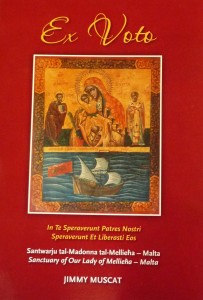 Infatti, kien proprju l-ktieb ta’ dan l-awtur ‘Ex-Voto: Santwarju tal-Madonna tal-Mellieħa’ li ġibidni lejn dan il-post. F’dan il-ktieb li hu wkoll speċi ta’ katalogu, Jimmy jippreżenta ġabra tal-110 kwadru ex-voto li rnexxielhom isalvaw sal-ġurnata ta’ llum f’dan is-santwarju, fejn 64 minnhom għandhom tema marittima, filwaqt li l-oħrajn juru xeni ta’ mard u inċidenti li n-nies irnexxielhom ifiequ minnhom. Naturalment, kull kwadru għandu l-istorja partikolari tiegħu imma mhux kull wieħed fih id-dettalji ta’ dan ir-rakkont miktubin fuqu. Uħud mill-kwadri għandhom xi deskrizzjoni ta’ dak li kien seħħ biex saret din il-pittura, oħrajn għandhom biss id-data mniżżla fuqhom, filwaqt li numru ieħor juru l-ittri V.F.G.A. (Votum Fecit Gratiam Accepit) li jfisser li l-wegħda ntalbet u l-grazzja nqalgħet. Fl-istess ħin, anki jekk numru ta’ xogħolijiet m’għandhom l-ebda kitba fuqhom, jekk wieħed jiflihom sewwa, xorta waħda jista’ jinnota xi dettalji li kapaċi jagħtuh indikazzjoni tal-kuntest tagħhom, bħal ngħidu aħna mit-tip ta’ xwieni, mill-bnadar li jkollhom fuqhom, mill-inħawi li jidhru fl-isfond, mill-ilbies tan-nies u mill-għamara tad-djar. Għaldaqstant, dawn l-ex-voto mhumiex biss xhieda tat-twemmin tal-popli matul iż-żminijiet imma anki riflessjoni tal-istorja u tas-soċjetajiet differenti li ħallew dan il-wirt tagħhom f’dan il-post.
Infatti, kien proprju l-ktieb ta’ dan l-awtur ‘Ex-Voto: Santwarju tal-Madonna tal-Mellieħa’ li ġibidni lejn dan il-post. F’dan il-ktieb li hu wkoll speċi ta’ katalogu, Jimmy jippreżenta ġabra tal-110 kwadru ex-voto li rnexxielhom isalvaw sal-ġurnata ta’ llum f’dan is-santwarju, fejn 64 minnhom għandhom tema marittima, filwaqt li l-oħrajn juru xeni ta’ mard u inċidenti li n-nies irnexxielhom ifiequ minnhom. Naturalment, kull kwadru għandu l-istorja partikolari tiegħu imma mhux kull wieħed fih id-dettalji ta’ dan ir-rakkont miktubin fuqu. Uħud mill-kwadri għandhom xi deskrizzjoni ta’ dak li kien seħħ biex saret din il-pittura, oħrajn għandhom biss id-data mniżżla fuqhom, filwaqt li numru ieħor juru l-ittri V.F.G.A. (Votum Fecit Gratiam Accepit) li jfisser li l-wegħda ntalbet u l-grazzja nqalgħet. Fl-istess ħin, anki jekk numru ta’ xogħolijiet m’għandhom l-ebda kitba fuqhom, jekk wieħed jiflihom sewwa, xorta waħda jista’ jinnota xi dettalji li kapaċi jagħtuh indikazzjoni tal-kuntest tagħhom, bħal ngħidu aħna mit-tip ta’ xwieni, mill-bnadar li jkollhom fuqhom, mill-inħawi li jidhru fl-isfond, mill-ilbies tan-nies u mill-għamara tad-djar. Għaldaqstant, dawn l-ex-voto mhumiex biss xhieda tat-twemmin tal-popli matul iż-żminijiet imma anki riflessjoni tal-istorja u tas-soċjetajiet differenti li ħallew dan il-wirt tagħhom f’dan il-post.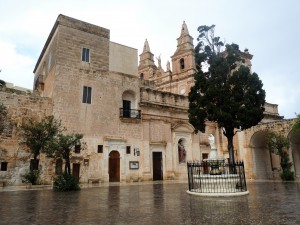 Imma, ejja nimxu lura fis-snin, lejn il-bidu ta’ dan is-sit… Skont l-istudji fl-istorja tal-Mellieħa li għamel Jimmy, jidher li qabel is-17 il-seklu, l-inħawi ta’ fejn illum jinsab dan is-santwarju, kienu biss għerien naturali. Minħabba l-attakki spissi tal-pirati li kienu jsibu l-bajja tal-Mellieħa mira faċli biex minnha jitilgħu l-art, l-inħawi tal-madwar kienu meqjusa bħala perikolużi wisq biex wieħed jgħix fihom. Probabbilment kien hemm xi wħud li kienu jazzardaw jgħixu f’xi għerien tal-madwar, imma dawn kienu jafu li kienu qed jilgħabu xortihom kuljum hemmhekk. Intant, skont xi dokumenti li nstabu, jidher li fl-1640 kien beda t-tħaffir tal-inħawi fejn illum jinsab is-santwarju. Iżda mill-ġdid, minħabba l-invażjonijiet minn perjodu għall-ieħor tal-pirati, intilfu ħafna dokumenti sinifikanti minn dan il-post u fil-fatt il-manuskritti li għandna llum jibdew mit-18 il-seklu.
Imma, ejja nimxu lura fis-snin, lejn il-bidu ta’ dan is-sit… Skont l-istudji fl-istorja tal-Mellieħa li għamel Jimmy, jidher li qabel is-17 il-seklu, l-inħawi ta’ fejn illum jinsab dan is-santwarju, kienu biss għerien naturali. Minħabba l-attakki spissi tal-pirati li kienu jsibu l-bajja tal-Mellieħa mira faċli biex minnha jitilgħu l-art, l-inħawi tal-madwar kienu meqjusa bħala perikolużi wisq biex wieħed jgħix fihom. Probabbilment kien hemm xi wħud li kienu jazzardaw jgħixu f’xi għerien tal-madwar, imma dawn kienu jafu li kienu qed jilgħabu xortihom kuljum hemmhekk. Intant, skont xi dokumenti li nstabu, jidher li fl-1640 kien beda t-tħaffir tal-inħawi fejn illum jinsab is-santwarju. Iżda mill-ġdid, minħabba l-invażjonijiet minn perjodu għall-ieħor tal-pirati, intilfu ħafna dokumenti sinifikanti minn dan il-post u fil-fatt il-manuskritti li għandna llum jibdew mit-18 il-seklu.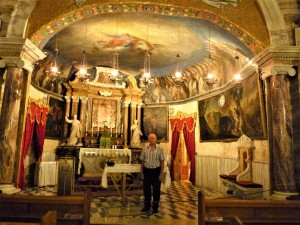 Il-ħaġa tal-iskantament hija illi għalkemm dawn l-inħawi kienu meqjusa tat-twegħir, bosta pellegrini xorta waħda kienu jirriskjaw ħajjithom sabiex iżuru wieħed minn dawn l-għerien li kien meqjus bħala sagru minħabba xbieha partikolari li kellu fuq il-ħajt. Dan għaliex it-tradizzjoni tgħid li din ix-xbieha tal-Madonna bil-Bambin f’idejha kien pinġiha fuq il-blat San Luqa, meta fis-sena 60W.K. huwa kien qiegħed f’Malta flimkien ma’ sieħbu San Pawl, u għalhekk din kienet ikkunsidrata bħala mirakoluża. Tradizzjoni oħra relatata ma’ dan il-post tirrakkonta illi fis-sena 409W.K. grupp ta’ isqfijiet kienu żaru dan l-għar u meta raw din it-tpinġija ta’ San Luqa mal-blat u t-twemmin sod li kien hemm marbut magħha, huma ddeċidew li jikkonsagraw dan il-post bħala knisja.
Il-ħaġa tal-iskantament hija illi għalkemm dawn l-inħawi kienu meqjusa tat-twegħir, bosta pellegrini xorta waħda kienu jirriskjaw ħajjithom sabiex iżuru wieħed minn dawn l-għerien li kien meqjus bħala sagru minħabba xbieha partikolari li kellu fuq il-ħajt. Dan għaliex it-tradizzjoni tgħid li din ix-xbieha tal-Madonna bil-Bambin f’idejha kien pinġiha fuq il-blat San Luqa, meta fis-sena 60W.K. huwa kien qiegħed f’Malta flimkien ma’ sieħbu San Pawl, u għalhekk din kienet ikkunsidrata bħala mirakoluża. Tradizzjoni oħra relatata ma’ dan il-post tirrakkonta illi fis-sena 409W.K. grupp ta’ isqfijiet kienu żaru dan l-għar u meta raw din it-tpinġija ta’ San Luqa mal-blat u t-twemmin sod li kien hemm marbut magħha, huma ddeċidew li jikkonsagraw dan il-post bħala knisja. Li nafu fiż-żgur huwa li maż-żmien, inbena santwarju sħiħ madwar ikona li turi x-xbieha tal-Madonna bil-Bambin f’idha. Barra minn hekk inbnew ukoll xi kmamar għall-pellegrini fejn dawn setgħu jistrieħu ftit qabel jerħulha lura lejn l-abitat tagħhom. Sal-ġurnata ta’ llum, bosta pellegrini għadhom iżuru dan il-post biex jitolbu l-għajnuna tal-Madonna tal-Mellieħa quddiem din ix-xbieha. Min-naħa l-oħra, xi studjużi tal-arti għandhom ukoll interess f’din ix-xbieha peress li għad hemm diversi mistoqsijiet relatati magħha. Fosthom hu maħsub li l-ikona li qed naraw fil-preżent, kienet saret fit-13 il-seklu. Iżda mid-dehra taħt din it-tpinġija, hemm oħra ferm aktar antika minnha, minħabba li waqt li kien qed isirilha xi restawr, beda joħroġ xi fdal tad-deheb minn taħtha. Dan jindika l-possibilità li jista’ jkun hemm xbieha eqdem mgħottija b’dik preżenti. Sadanittant, minn dokumenti tal-visti pastorali li saru matul is-snin, Jimmy skopra li għal aktar minn darba, l-isqfijiet ta’ dawk il-perjodi kienu qed jinnutaw li x-xbieha tal-Madonna kienet qed tisfuma biż-żmien u għalhekk huma talbu biex titpinġa oħra fuqha sabiex il-pellegrini jkunu jistgħu jibqgħu jaraw u jidentifikaw max-xbieha tal-Madonna li għaliha kienu qed jiġu f’dan il-post.
Li nafu fiż-żgur huwa li maż-żmien, inbena santwarju sħiħ madwar ikona li turi x-xbieha tal-Madonna bil-Bambin f’idha. Barra minn hekk inbnew ukoll xi kmamar għall-pellegrini fejn dawn setgħu jistrieħu ftit qabel jerħulha lura lejn l-abitat tagħhom. Sal-ġurnata ta’ llum, bosta pellegrini għadhom iżuru dan il-post biex jitolbu l-għajnuna tal-Madonna tal-Mellieħa quddiem din ix-xbieha. Min-naħa l-oħra, xi studjużi tal-arti għandhom ukoll interess f’din ix-xbieha peress li għad hemm diversi mistoqsijiet relatati magħha. Fosthom hu maħsub li l-ikona li qed naraw fil-preżent, kienet saret fit-13 il-seklu. Iżda mid-dehra taħt din it-tpinġija, hemm oħra ferm aktar antika minnha, minħabba li waqt li kien qed isirilha xi restawr, beda joħroġ xi fdal tad-deheb minn taħtha. Dan jindika l-possibilità li jista’ jkun hemm xbieha eqdem mgħottija b’dik preżenti. Sadanittant, minn dokumenti tal-visti pastorali li saru matul is-snin, Jimmy skopra li għal aktar minn darba, l-isqfijiet ta’ dawk il-perjodi kienu qed jinnutaw li x-xbieha tal-Madonna kienet qed tisfuma biż-żmien u għalhekk huma talbu biex titpinġa oħra fuqha sabiex il-pellegrini jkunu jistgħu jibqgħu jaraw u jidentifikaw max-xbieha tal-Madonna li għaliha kienu qed jiġu f’dan il-post.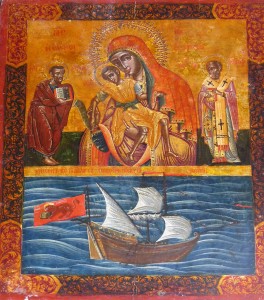 Hekk kif għajnejja ġrew fuq l-ammonti ta’ kwadri ex-voto li jmorru lura għal mijiet ta’ snin, fihom ilmaħt it-tama ta’ bosta individwi li akkost li kienu f’ibħra ‘l bogħod minn xtutna, talbiethom xorta waħda daret lejn il-Madonna li fiha huma kellhom l-akbar fiduċja – dik tas-Santwarju tal-Mellieħa. Iżda ma kienux biss il-Maltin li kienu jiggranfaw ma’ din il-karba għall-għajnuna divina ta’ din il-Madonna meta l-mewt kienet daqstant viċin! Infatti kienu ħafna l-individwi barranin li kienu rregalaw il-kwadri ex-voto tagħhom lil dan is-santwarju meta rritornaw qawwijin u sħaħ lejn pajjiżna. Fost dawn kien hemm il-ġeneral tal-flotta tal-Ordni, Fra Antonio Correa (Montenegro) li wiegħed u ta kwadru mill-isbaħ lill-Madonna tas-Santwarju tal-Mellieħa wara li x-xwieni li kien responsabbli minnhom inqabdu f’maltempata tal-biża’ waqt li kienu qed jaqsmu u jbaħħru qrib il-gżejjer ta’ Taranto fl-1678 u finalment irnexxielhom isalvaw. Ex-voto ieħor pjuttost kurjuż huwa dak li jidher proprju fil-qoxra tal-ktieb ta’ Jimmy fejn did-darba, il-Madonna li tidher fuq ix-xbieha tal-ex-voto, tixbaħ ħafna lill-Madonna tal-Monasteru ta’ Kykkos li jinsab f’Ċipru u għalhekk hija għal kollox differenti minn dik tal-Mellieħa. Għaldaqstant wieħed jistaqsi kif dan ix-xogħol ġie inkluż ma’ din il-kollezzjoni tas-santwarju? Kitba fuq dan l-ex-voto li tidher li hi ta’ lingwa antika Russa u Griega, taf tipprovdi xi indikazzjoni dwar din ir-raġuni, iżda s’issa ħadd għadu ma rnexxielu jiddeċifra x’hemm miktub.
Hekk kif għajnejja ġrew fuq l-ammonti ta’ kwadri ex-voto li jmorru lura għal mijiet ta’ snin, fihom ilmaħt it-tama ta’ bosta individwi li akkost li kienu f’ibħra ‘l bogħod minn xtutna, talbiethom xorta waħda daret lejn il-Madonna li fiha huma kellhom l-akbar fiduċja – dik tas-Santwarju tal-Mellieħa. Iżda ma kienux biss il-Maltin li kienu jiggranfaw ma’ din il-karba għall-għajnuna divina ta’ din il-Madonna meta l-mewt kienet daqstant viċin! Infatti kienu ħafna l-individwi barranin li kienu rregalaw il-kwadri ex-voto tagħhom lil dan is-santwarju meta rritornaw qawwijin u sħaħ lejn pajjiżna. Fost dawn kien hemm il-ġeneral tal-flotta tal-Ordni, Fra Antonio Correa (Montenegro) li wiegħed u ta kwadru mill-isbaħ lill-Madonna tas-Santwarju tal-Mellieħa wara li x-xwieni li kien responsabbli minnhom inqabdu f’maltempata tal-biża’ waqt li kienu qed jaqsmu u jbaħħru qrib il-gżejjer ta’ Taranto fl-1678 u finalment irnexxielhom isalvaw. Ex-voto ieħor pjuttost kurjuż huwa dak li jidher proprju fil-qoxra tal-ktieb ta’ Jimmy fejn did-darba, il-Madonna li tidher fuq ix-xbieha tal-ex-voto, tixbaħ ħafna lill-Madonna tal-Monasteru ta’ Kykkos li jinsab f’Ċipru u għalhekk hija għal kollox differenti minn dik tal-Mellieħa. Għaldaqstant wieħed jistaqsi kif dan ix-xogħol ġie inkluż ma’ din il-kollezzjoni tas-santwarju? Kitba fuq dan l-ex-voto li tidher li hi ta’ lingwa antika Russa u Griega, taf tipprovdi xi indikazzjoni dwar din ir-raġuni, iżda s’issa ħadd għadu ma rnexxielu jiddeċifra x’hemm miktub.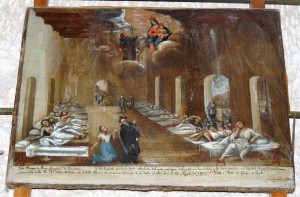 Kwadri oħra, daqstant emozzjonali, juru persuni jew familji qed jitolbu bil-ħrara għall-qraba morda tagħhom u mill-ġdid hawnhekk, apparti li f’dawn il-wegħdi naraw is-simboli tat-twemmin, fl-istess ħin għandna stampa ċara tas-sitwazzjoni tas-saħħa li kien hawn f’pajjiżna matul is-snin, fejn fosthom uħud kienu mardu bil-malarja, bit-tuberkolożi, bil-pneumonia, bil-ġidri, bil-kolera, bid-difterite u anki bil-pesta. Fost dawn, laqgħatni ħafna kwadru minnhom li juri xena ta’ sptar tal-pesta tal-1813. Dan il-kwadru kien wiegħda magħmulha minn Anna Lungaro u l-qarib tagħha Giovanni Portelli peress li hi kienet mardet bil-marda tal-pesta u permezz tal-ħniena divina tal-Madonna tal-Mellieħa, nhar it-Tlieta, 17 t’Awwissu 1813, hi u tnejn oħra biss mill-160 persuna li kien hemm fl-isptar tal-pesta, irnexxielhom isalvaw.
Kwadri oħra, daqstant emozzjonali, juru persuni jew familji qed jitolbu bil-ħrara għall-qraba morda tagħhom u mill-ġdid hawnhekk, apparti li f’dawn il-wegħdi naraw is-simboli tat-twemmin, fl-istess ħin għandna stampa ċara tas-sitwazzjoni tas-saħħa li kien hawn f’pajjiżna matul is-snin, fejn fosthom uħud kienu mardu bil-malarja, bit-tuberkolożi, bil-pneumonia, bil-ġidri, bil-kolera, bid-difterite u anki bil-pesta. Fost dawn, laqgħatni ħafna kwadru minnhom li juri xena ta’ sptar tal-pesta tal-1813. Dan il-kwadru kien wiegħda magħmulha minn Anna Lungaro u l-qarib tagħha Giovanni Portelli peress li hi kienet mardet bil-marda tal-pesta u permezz tal-ħniena divina tal-Madonna tal-Mellieħa, nhar it-Tlieta, 17 t’Awwissu 1813, hi u tnejn oħra biss mill-160 persuna li kien hemm fl-isptar tal-pesta, irnexxielhom isalvaw.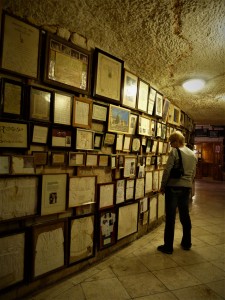 Jimmy kompla jdawwarni madwar is-santwarju li ġewwa fih jinkorpora wkoll l-għerien naturali tal-post li indubbjament jagħtuh laqta’ pjuttost insolita u surreali. Iżda daqstant ieħor bqajt impressjonata bil-kwantità ta’ ex-voto oħrajn li kellhom kull xorta ta’ forma: ittri, ritratti, x-rays, ċertifikati, ilbies tat-trabi, krozzi, u dak kollu li tista’ timmaġina. Wegħdi magħmula mhux biss mill-Maltin imma minn kull ġens li qatt żar dan il-post. Infatti peress li fil-Mellieħa hemm diversi lukandi, it-turisti spiss isibu ruħhom f’dan il-lok, u anki dawk li mhumiex Kristjani, xorta waħda jiġu mistiedna biex jittawwlu u jaraw x’hemm. Uħud minn dawn, imqanqla minn dik ix-xhieda kollha ta’ sabar, fejqan u mirakli, bla ma jafu kif, isibu ruħhom huma wkoll jitolbu l-għajnuna quddiem il-Madonna u numru minnhom, jerġgħu jirritornaw lura lejn gżiritna bir-rigal tagħhom meta talbhom jinstema’. Minn fost il-ħafna oġġetti li kien hemm, sibt ruħi qiegħda naqra ġrajja minn ġurnal li kienet qed tirrakkonta kif koppja Ingliża li t-tobba kienu qatgħulhom qalbhom li għad ikollhom tarbija, meta żaru dan is-santwarju u għamlu t-talba tagħhom, huma rritornaw lejn artna tmien snin wara b’żewġt itfal tagħhom.
Jimmy kompla jdawwarni madwar is-santwarju li ġewwa fih jinkorpora wkoll l-għerien naturali tal-post li indubbjament jagħtuh laqta’ pjuttost insolita u surreali. Iżda daqstant ieħor bqajt impressjonata bil-kwantità ta’ ex-voto oħrajn li kellhom kull xorta ta’ forma: ittri, ritratti, x-rays, ċertifikati, ilbies tat-trabi, krozzi, u dak kollu li tista’ timmaġina. Wegħdi magħmula mhux biss mill-Maltin imma minn kull ġens li qatt żar dan il-post. Infatti peress li fil-Mellieħa hemm diversi lukandi, it-turisti spiss isibu ruħhom f’dan il-lok, u anki dawk li mhumiex Kristjani, xorta waħda jiġu mistiedna biex jittawwlu u jaraw x’hemm. Uħud minn dawn, imqanqla minn dik ix-xhieda kollha ta’ sabar, fejqan u mirakli, bla ma jafu kif, isibu ruħhom huma wkoll jitolbu l-għajnuna quddiem il-Madonna u numru minnhom, jerġgħu jirritornaw lura lejn gżiritna bir-rigal tagħhom meta talbhom jinstema’. Minn fost il-ħafna oġġetti li kien hemm, sibt ruħi qiegħda naqra ġrajja minn ġurnal li kienet qed tirrakkonta kif koppja Ingliża li t-tobba kienu qatgħulhom qalbhom li għad ikollhom tarbija, meta żaru dan is-santwarju u għamlu t-talba tagħhom, huma rritornaw lejn artna tmien snin wara b’żewġt itfal tagħhom.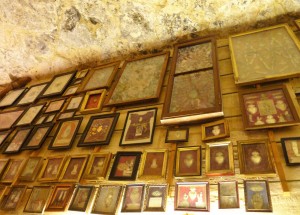 Ex-voto oħra ta’ qisien differenti, li ħafna minnhom ġew maħdumin mill-fidda fid-19 il-seklu, juru diversi partijiet tal-ġisem bħala rappreżentazzjoni ta’ b’hiex kien marid l-individwu li għamel il-wegħda. Numru minnhom għandhom forma ta’ qalb imma dawn huma simbolu tal-imħabba lejn il-Madonna. Oħrajn juru par għajnejn u id u dawn kienu jissimbolizzaw is-superstizzjoni tal-magħmul li ġej mill-għajn. Bħall-oġġetti l-oħra, anki dawn jitfgħu dawl fuq is-soċjetà li għamlithom, hekk kif l-abbundanza li ngħataw biha u l-fatt li ħafna minnhom huma identiċi, juru li tant kien hemm talba għal dawn il-wegħdi, li dawn l-oġġetti kienu qed jiġu manifatturati fil-kwantità u mibjugħa. Iżda darba minnhom kien ġie żmien meta isqof partikolari kien beda jitnaffar minn dawn l-affarijiet, uħud minnhom saħansitra superstizzjużi, imwaħħla madwar l-artali tal-knejjes kollha! U għalhekk hu ordna li dawn kellhom jitneħħew minnufih u jiġu merfugħa fis-sagristija, b’eċċezzjoni tal-qalb li kienet tirrappreżenta l-imħabba lejn il-Madonna. Infatti Jimmy għadu sa llum isib minn dawn l-ex-voto fil-kaxxi iżda hu jemmen li rigward dawn il-wegħdi, jiswew kemm jiswew, u juru x’juru, jeżisti l-obbligu li dawn jintwerew fil-pubbliku peress li huma kienu kollha doni li ngħataw b’qima, b’rispett u b’imħabba lill-Madonna. Għaldaqstant hu qed jagħmel minn kollox biex jesponi kull oġġett li jingħata lis-santwarju, akkost il-problema tal-ispazju u l-fatt li dawn il-wegħdi għadhom deħlin.
Ex-voto oħra ta’ qisien differenti, li ħafna minnhom ġew maħdumin mill-fidda fid-19 il-seklu, juru diversi partijiet tal-ġisem bħala rappreżentazzjoni ta’ b’hiex kien marid l-individwu li għamel il-wegħda. Numru minnhom għandhom forma ta’ qalb imma dawn huma simbolu tal-imħabba lejn il-Madonna. Oħrajn juru par għajnejn u id u dawn kienu jissimbolizzaw is-superstizzjoni tal-magħmul li ġej mill-għajn. Bħall-oġġetti l-oħra, anki dawn jitfgħu dawl fuq is-soċjetà li għamlithom, hekk kif l-abbundanza li ngħataw biha u l-fatt li ħafna minnhom huma identiċi, juru li tant kien hemm talba għal dawn il-wegħdi, li dawn l-oġġetti kienu qed jiġu manifatturati fil-kwantità u mibjugħa. Iżda darba minnhom kien ġie żmien meta isqof partikolari kien beda jitnaffar minn dawn l-affarijiet, uħud minnhom saħansitra superstizzjużi, imwaħħla madwar l-artali tal-knejjes kollha! U għalhekk hu ordna li dawn kellhom jitneħħew minnufih u jiġu merfugħa fis-sagristija, b’eċċezzjoni tal-qalb li kienet tirrappreżenta l-imħabba lejn il-Madonna. Infatti Jimmy għadu sa llum isib minn dawn l-ex-voto fil-kaxxi iżda hu jemmen li rigward dawn il-wegħdi, jiswew kemm jiswew, u juru x’juru, jeżisti l-obbligu li dawn jintwerew fil-pubbliku peress li huma kienu kollha doni li ngħataw b’qima, b’rispett u b’imħabba lill-Madonna. Għaldaqstant hu qed jagħmel minn kollox biex jesponi kull oġġett li jingħata lis-santwarju, akkost il-problema tal-ispazju u l-fatt li dawn il-wegħdi għadhom deħlin.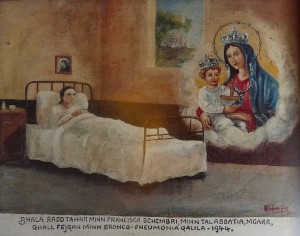 Proġett ieħor li dejjem isus fuq moħħ Jimmy jirrigwarda r-restawr tal-kwadri ex-voto sabiex dawn jiġu konservati għar-referenza tal-ġenerazzjonijiet li ġejjin warajna. Huwa jixtieq ħafna li jsib xi sponsors li jkunu jistgħu jagħtuh daqqa t’id biex isir dan ir-restawr. Sfortunatament, in-nuqqas ta’ għarfien fiż-żminijiet antiki dwar kif kien l-aħjar mezz kif jinżammu oġġetti bħal dawn, kien wassal għall-qerda ta’ għadd ta’ kwadri sinifikanti u min jaf kemm informazzjoni ntilfet! Infatti bosta minn dawn il-kwadri kienu ġew mormija wara li sofrew danni peress li tpoġġew direttament fuq blat umduż, filwaqt li oħrajn ġew anki maħsula bl-ilma wara li swiedu minħabba n-nugrufun li tqanqal mill-kwantità ta’ xemgħat u ftili taż-żejt li kienu jinxtegħlu għal siegħat twal fis-santwarju!
Proġett ieħor li dejjem isus fuq moħħ Jimmy jirrigwarda r-restawr tal-kwadri ex-voto sabiex dawn jiġu konservati għar-referenza tal-ġenerazzjonijiet li ġejjin warajna. Huwa jixtieq ħafna li jsib xi sponsors li jkunu jistgħu jagħtuh daqqa t’id biex isir dan ir-restawr. Sfortunatament, in-nuqqas ta’ għarfien fiż-żminijiet antiki dwar kif kien l-aħjar mezz kif jinżammu oġġetti bħal dawn, kien wassal għall-qerda ta’ għadd ta’ kwadri sinifikanti u min jaf kemm informazzjoni ntilfet! Infatti bosta minn dawn il-kwadri kienu ġew mormija wara li sofrew danni peress li tpoġġew direttament fuq blat umduż, filwaqt li oħrajn ġew anki maħsula bl-ilma wara li swiedu minħabba n-nugrufun li tqanqal mill-kwantità ta’ xemgħat u ftili taż-żejt li kienu jinxtegħlu għal siegħat twal fis-santwarju! Temminx jew le f’dawn il-mirakli jew fl-istess reliġjon innifsu, ma naħsibx li tista’ tibqa’ biered għal kollox fil-preżenza ta’ din il-ġabra mmensa tat-tifkiriet ta’ nies li emmnu, afdaw u qalgħu l-għajnuna meta l-aktar li kellhom bżonnha. Ċertament jagħmel tajjeb li kieku intom jirnexxielkhom issibu ftit ħin biex iżżuru dan il-post sinifikanti ħafna f’pajjiżna u fil-kultura tagħna sabiex b’hekk taraw b’għajnejkhom, tmissu b’idejkhom u tħossu b’qalbkhom.
Temminx jew le f’dawn il-mirakli jew fl-istess reliġjon innifsu, ma naħsibx li tista’ tibqa’ biered għal kollox fil-preżenza ta’ din il-ġabra mmensa tat-tifkiriet ta’ nies li emmnu, afdaw u qalgħu l-għajnuna meta l-aktar li kellhom bżonnha. Ċertament jagħmel tajjeb li kieku intom jirnexxielkhom issibu ftit ħin biex iżżuru dan il-post sinifikanti ħafna f’pajjiżna u fil-kultura tagħna sabiex b’hekk taraw b’għajnejkhom, tmissu b’idejkhom u tħossu b’qalbkhom.Is-Santwarju tal-Madonna tal-Mellieħa jkun miftuħ mis-7.00am sa nofsinhar u mill-4.00pm sas-6.00pm. Issir ukoll quddiesa kuljum fit-8.30am, filwaqt li dik tal-Ħadd tibda fl-10.00am u tkun bl-Ingliż.
(Dan l-artiklu ġie ppubblikat fit-Torċa tas-26 ta’ Jannar 2014 fis-sensiela Ġabriet it-Tifkiriet)
-
Walk this way
When there is such a wide selection of travel destinations, why should one opt to go on a pilgrimage?
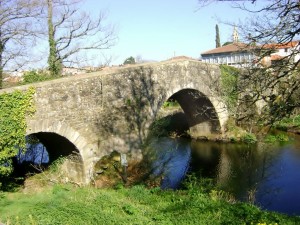 “I did ask that question to myself on the first day of my Camino,” revealed Matthias Ebejer. “The walk to Santiago de Compostela in northwest Spain is not a travel holiday like many others. It can be quite a shock for those who are not used to outdoor activities such as hiking, trekking or camping. On the other hand, it can prove to be pretty challenging to find the real meaning of it all if one is regularly accustomed to such adventures.”
“I did ask that question to myself on the first day of my Camino,” revealed Matthias Ebejer. “The walk to Santiago de Compostela in northwest Spain is not a travel holiday like many others. It can be quite a shock for those who are not used to outdoor activities such as hiking, trekking or camping. On the other hand, it can prove to be pretty challenging to find the real meaning of it all if one is regularly accustomed to such adventures.”Matthias was definitely not one of the latter. He was enticed to go on this pilgrimage by his girlfriend Deborah since she had already experienced it together with her family.
“It did not take her much to convince me. As I began to look for information about this walk, I realized that this was the perfect way to get to know Spain closely. Such a pilgrimage gives you the opportunity to walk from one village to another, crossing different regions, meeting all sorts of people and learning about their culture and the places’s history. It is also very interesting to observe the changing architectural styles, cuisine forms, and people’s mentalities as you move along the rural areas which turn into urban locations as you get closer to the final destination.”
 As a historian specializing in the history of the Knights Hospitallers of the Order of St John, Matthias had a further motive to try out this pilgrimage.
As a historian specializing in the history of the Knights Hospitallers of the Order of St John, Matthias had a further motive to try out this pilgrimage.“The Order was established to provide care for the sick, poor or injured pilgrims who visited the Holy Land. Yet eventually, these knights were also protecting the Christian pilgrims who travelled the St James’ Way to Santiago de Compostela. They constructed cathedrals, monasteries and pilgrims’ hostels along the route, some of which still exist today, such as the Cathedral of Portomarin, my favourite stop along the Camino. Portomarin was originally a Hospitaller commandery, and it indicated the part of the walk which was guarded by the Knights of St John. Pilgrim museums located in the various villages and towns along the Camino are quite informative and inspiring. A number of them are found within small churches or large cathedrals but one can also visit private houses which used to belong to wealthy pilgrims who donated their dwellings to become museums.”
 Although Santiago de Compostela has been associated with spirituality since olden times, it was the miraculous discovery of the remains of the apostle James in the ninth century in this area which made this Galician town so popular. These remains were buried in the site upon which the renowned cathedral of this town was later built.
Although Santiago de Compostela has been associated with spirituality since olden times, it was the miraculous discovery of the remains of the apostle James in the ninth century in this area which made this Galician town so popular. These remains were buried in the site upon which the renowned cathedral of this town was later built.“The authenticity of this legend has often created disputes in the Catholic Church since there are those who have their doubts about who is really buried in the crypt of this cathedral. Nevertheless, I believe that such controversy is superfluous because independently of who is buried within the silver box that lies at the heart of this holy site, the ultimate goal of each pilgrim is to stop there and meditate about the journey made and to liberate oneself from the troubling baggage of problems that one has carried along in order to come out as a new person.”
Thousands of pilgrims have walked this path for the last one thousand years and yet ‘the way’ is a very personal journey.
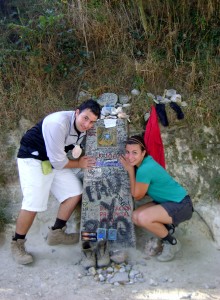 “I am a Catholic, however I am not a religious person. I must admit that my original aim for this walk was more based on cultural interest rather than a spiritual one. Yet such pilgrimages are full of surprises and my walk ended up giving me much more than that.”
“I am a Catholic, however I am not a religious person. I must admit that my original aim for this walk was more based on cultural interest rather than a spiritual one. Yet such pilgrimages are full of surprises and my walk ended up giving me much more than that.”The origin of such pilgrimages was generally based on sacrifice and repentance from one’s sins. Nowadays, things have changed and the aim for such an experience depends on each individual.
“This pilgrimage is not necessarily meant to be a sacrifice. One is not expected to suffer or to be in pain. I must say that today such a pilgrimage is more a reaction to that universal urge to leave the safety of home in order to find oneself. One has several options from where to start this pilgrimage and each have different levels of difficulties. The longest and most popular route is the Camino Francés which stretches 780 km from St. Jean-Pied-du-Port near Biarritz in France to Santiago.”
Matthew has participated two times in the Camino. The first time was 213 kms long, leaving from Ponferrada in Spain and taking 9 days to finish. The second one was 100 kms long, being the minimum distance, leaving from Sarria and taking 5 days to arrive to Santiago de Compostela.
 “Each time I went with a group of friends. The Camino we chose was not difficult and we walked about 20 to 25 kms daily. Friends provide good company and they also help you to go on whenever you might feel discouraged or tempted to stop. The walk was always deeply moving and enriching. Travelling on foot provides you with the leisure to look around you, to feel the earth beneath your feet, to breathe the fresh air and enjoy the various scents of the surrounding landscapes, and to listen to the sounds or relish the silence. It also presents you with those significant moments wherein you are walking alone thinking about your life, the decisions you made or are about to make, and the meaning of living itself. Although initially one might start this pilgrimage as a mere tourist, at the end of it one will recognize a considerable change in oneself.”
“Each time I went with a group of friends. The Camino we chose was not difficult and we walked about 20 to 25 kms daily. Friends provide good company and they also help you to go on whenever you might feel discouraged or tempted to stop. The walk was always deeply moving and enriching. Travelling on foot provides you with the leisure to look around you, to feel the earth beneath your feet, to breathe the fresh air and enjoy the various scents of the surrounding landscapes, and to listen to the sounds or relish the silence. It also presents you with those significant moments wherein you are walking alone thinking about your life, the decisions you made or are about to make, and the meaning of living itself. Although initially one might start this pilgrimage as a mere tourist, at the end of it one will recognize a considerable change in oneself.”During his research, Matthew discovered that even the kings of Spain participated in the Camino as part of an old tradition. Later on, during the walk he was informed that up to the present days, prisoners who have a good conduct are offered the opportunity to spend the last six months of their sentence walking the Camino with a guardian instead of spending them in prison.
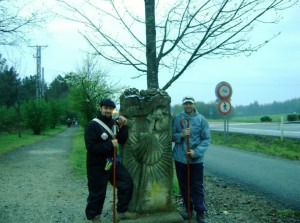 “You meet several people along this pilgrimage and you get the privilege to listen to their stories about why they chose to do this walk. Some of these narratives are very touching such as that of the Scandinavian eighty-year old man who had lost his wife some years before. As he walked part of the way with me, he told me how he had become very depressed by her death and had given up on life, waiting for his end to come soon. Then one day, he decided to stop mourning and to regain the joy of life again. After seeking help from a travel agency, he was recommended to try out the Camino and there he was seeking a way to turn a new page in his life.”
“You meet several people along this pilgrimage and you get the privilege to listen to their stories about why they chose to do this walk. Some of these narratives are very touching such as that of the Scandinavian eighty-year old man who had lost his wife some years before. As he walked part of the way with me, he told me how he had become very depressed by her death and had given up on life, waiting for his end to come soon. Then one day, he decided to stop mourning and to regain the joy of life again. After seeking help from a travel agency, he was recommended to try out the Camino and there he was seeking a way to turn a new page in his life.”One can choose the level of comfort and also the means how to do this pilgrimage. Hostels, hotels, restaurants, bars and shops are available all along the route which one can travel by walking, cycling, horse riding or even by car, although the latter does not count much.
 “When you decide which route you are going to take, you can buy a guidebook online and prepare your journey beforehand. These guidebooks will provide you with all the required information and also with recommendations where to stop. We used to start walking very early in the morning when it was still dark. After a 3km walk, we would stop to eat breakfast and then continue along the way for a further 17kms until we reached the next village or town, generally at around 12:30pm. We chose to rest at municipal hostels wherein we could take a shower, cook some food in the kitchen, wash our clothes and sleep in the dormitory for the price of 5 euros. Such an arrangement gave us the opportunity to visit the village or town in which we stopped or to eat a good meal at a restaurant whenever we felt like it.”
“When you decide which route you are going to take, you can buy a guidebook online and prepare your journey beforehand. These guidebooks will provide you with all the required information and also with recommendations where to stop. We used to start walking very early in the morning when it was still dark. After a 3km walk, we would stop to eat breakfast and then continue along the way for a further 17kms until we reached the next village or town, generally at around 12:30pm. We chose to rest at municipal hostels wherein we could take a shower, cook some food in the kitchen, wash our clothes and sleep in the dormitory for the price of 5 euros. Such an arrangement gave us the opportunity to visit the village or town in which we stopped or to eat a good meal at a restaurant whenever we felt like it.”“The secret is to travel as light as possible and to learn to live with the barest minimum. To cater for the changing weather, one should carry basic layering of clothing and everything should be waterproof. A first-aid kit which includes talc, cream against sores and adhesive bandages is a must. A torch is necessary to find the way in the dark. One must not forget to take any required medicine and also a medical prescription in case something happens to it. Ear plugs could be helpful when sleeping in dormitories. However one of the most important items is a comfortable and sturdy pair of shoes.”
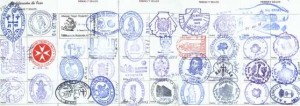 One should definitely not do this pilgrimage without carrying a pilgrim passport or credencial along with him.
One should definitely not do this pilgrimage without carrying a pilgrim passport or credencial along with him.“We obtained our credencial from the Curia of Madrid. This is a blank passport which one stamps along the way in order to confirm one’s participation in the pilgrimage. Many places are equipped with their unique Camino stamps along the route and we loved to go in search of the most appealing ones. When presented duly stamped at Santiago de Compostela, each pilgrim is given a certificate and a plenary indulgence. Eventually, this credencial becomes a very dear memento of this journey.”
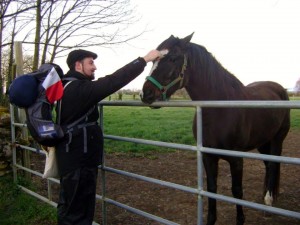 “Two other things which should be obtained before starting the walk is the pilgrims’ scallop shell and walking stick. We also placed a Maltese flag on our backpack and this was always a good conversation starter with other pilgrims. At the end of our pilgrimage, we made it a point to arrive in Santiago in time for the noon pilgrims’ mass where we received the blessing. Although we had walked for 20 kms, this experience was so uplifting and emotional that we felt no fatigue even though we had to stand up for an hour and a half as the cathedral was packed with people.”
“Two other things which should be obtained before starting the walk is the pilgrims’ scallop shell and walking stick. We also placed a Maltese flag on our backpack and this was always a good conversation starter with other pilgrims. At the end of our pilgrimage, we made it a point to arrive in Santiago in time for the noon pilgrims’ mass where we received the blessing. Although we had walked for 20 kms, this experience was so uplifting and emotional that we felt no fatigue even though we had to stand up for an hour and a half as the cathedral was packed with people.”Matthew’s first pilgrimage ended at Finisterre and the second at La Coruna.
 “Pilgrims used to walk another three to five days to reach the shores of Finisterre and Muxia, at the extreme point of Spain facing the Atlantic, the edge of the known world. There they would collect the scallop shells as a sign that they had walked the Camino. Legend has it that the body of St James was brought back from Jerusalem from these shores.”
“Pilgrims used to walk another three to five days to reach the shores of Finisterre and Muxia, at the extreme point of Spain facing the Atlantic, the edge of the known world. There they would collect the scallop shells as a sign that they had walked the Camino. Legend has it that the body of St James was brought back from Jerusalem from these shores.”“At Finisterre there is the tradition to throw away the walking stick which has accompanied you along your pilgrimage into the sea and then burn some of your clothes. This symbolically means that you have walked the way, that you have searched for answers and found them, and that now you are leaving the pilgrim’s life behind in order to go on with your life.”
(This article was published in the Travel Supplement issued with The Times of Malta dated 29th March 2017)
-
Love is strange doctor
 Choosing a unique white wedding dress, sending out elegant invitations to guests, being led down the aisle by one’s father, shamelessly removing the garter, tossing the colourful bouquet, and giving out souvenirs may be considered as universal marriage traditions. However the reality is far from that. Rituals and customs could vary greatly between cultures, religions and countries, ranging from the sweet and romantic, to the strange and bizarre and at times even to the shocking and outrageous.
Choosing a unique white wedding dress, sending out elegant invitations to guests, being led down the aisle by one’s father, shamelessly removing the garter, tossing the colourful bouquet, and giving out souvenirs may be considered as universal marriage traditions. However the reality is far from that. Rituals and customs could vary greatly between cultures, religions and countries, ranging from the sweet and romantic, to the strange and bizarre and at times even to the shocking and outrageous.Ghost weddings – China
Whereas a wedding is generally expected to be the culmination of a loving and living bride and groom, ghost weddings are still celebrated in some provinces of northern and central China such as Shanxi and Henan. Such weddings are based on a grisly 3000 year old tradition which recommends that the unmarried dead sould not be left alone in the afterlife, otherwise the deceased’s family might get cursed.
Originally this ritual was strictly for the dead and it involved two unmarried dead people. A wedding ceremony was duly celebrated and the two were buried together in the groom’s grave. Mainly aimed for young unmarried men who worked in coal mining and often suffered fatalities, this custom provided the bereaved parents with the opportunity to help their sons find a soulmate and be at peace even after death. It must be said that traditionally, parents felt obliged to assist their sons to settle down in a marriage.
Although this tradition is supposed to have ended, especially with the sale of corpses being outlawed in China in 2006, studies and police reports show that this ritual is more alive than ever. Worse than that, besides being practised secretely, this custom has mutated to a more appalling nature, leading to grave robberies and at times even murders. Prices for female corpses or human remains have increased considerably as parents are ready to carry the financial burden, no matter how difficult it might be.
Fat farms for brides – Mauritania
While many brides go on strict diets to lose weight before the wedding, in rural Mauritania, an attractive bride is a girl with stomach rolls, stretch marks and overlapping thighs. In this society, a thin girl is considered inferior and unappealing and her slim figure will bring shame to her family. An old tradition in this country, known as leblouh, ensures that girls are round and corpulent at their weddings by force feeding them from the tender age of 5.
During the school holidays or in the rainy season, when milk is abundant, girls are sent to ‘fattening farms’ where they are constrained to eat by older women, their aunts or grandmothers. A typical daily intake for a six year old includes two kilos of pounded millet blended with two cups of butter, as well as 20 litres of camel’s milk. Refusal to eat all this food will lead to a subtle form of corporal punishment such as squeezing the girls’ toes between two sticks. Vomit has to be consumed again.
Historians claim that this tradition dates back to pre-colonial times when Mauritania’s population consisted of nomad white Moor Arabs. At the time, a man was deemed wealthy and well respected if his wives could afford to sit still all day and leave the household chores to black slaves. This laziness led these women to gain weight and by time, being overweight became culturally acceptable and regarded as high class.
Even though health campaigners are trying to eradicate this old tradition, the leblouh practice has seen a resurgence in recent years. A successful fattenning process will make a girl of 15 look 30, making it easier for her to get married. Sadly, this custom causes endless illnesses and health problems to these girls in later years.
Cursed wives – India
When searching for a girl to marry, one tends to be attracted by looks or a charming personality. Yet in India, a man has to watch out for more than that since a woman born under Mangal Dosha (a Hindu astrological combination under the influence of planet Mars) is believed to be cursed and after marriage, she might lead to his untimely death.
Such women are known as Mangliks and are looked upon with fear in Hindu society. Their choice of spouse is very limited as they are clearly not regarded as ideal prospective matches in the arranged marriages which take place in this country.
A remedy to break this curse is to marry a clay pot during the kumbh vivah ceremony. This function is just like a real Hindu wedding where the woman has to wear a wedding dress and jewelery along with a thread. A priest is invited to chant the mantra and a marriage celebration takes place between the woman and the pot. Once the wedding is over, the bride will change her clothes, remove the thread and tie it around the pot. Later, when no one is watching, the pot will be drowned in a pond or in a river, thereby releasing the woman from the curse and making her suitable to marry a man.
Spitting on the bride – Kenya
One of the most emotional moments in a wedding is the point when a father accompanies his daughter down the aisle, then removes her veil and kisses her on her cheek before handing her over to her future husband. Yet although similar emotions will be involved during a wedding celebration of the Maasai people in Kenya, the father of the bride will spit on her in order to bless her.
Whereas spitting in many cultures is associated with disgrace and humiliation, in this tribe, this act is regarded to bring good luck and fortune. In fact, Maasai tribesmen will spit on their hands before greeting and shaking hands with elders and it is also customary for them to spit on newborns in order to avert any bad luck.
During a Maasai wedding, the bride’s head is shaved and lamb fat and oil is applied on her head. After her father has spit on her head and breasts, she will leave with her husband and walk away without looking back since she is fearful that she might turn into stone.
(This article was published in The Wedding Supplement issued with The Sunday Times of Malta dated 12th March 2017)
-
A sea of profits
A search through historical notarial deeds reveals how Maltese businesses exploited the cruel reality of war and slavery, maritime historian Dr Joan Abela tells Fiona Vella.
 “Even though there are people who might think that the human tragedy which we are experiencing today in the Mediterranean Sea may be something contemporary, in reality, the human element has always been an issue in this region,” Dr Joan Abela says as she refers me to some thick manuscripts that she had set aside at the Notarial Archives in Valletta.
“Even though there are people who might think that the human tragedy which we are experiencing today in the Mediterranean Sea may be something contemporary, in reality, the human element has always been an issue in this region,” Dr Joan Abela says as she refers me to some thick manuscripts that she had set aside at the Notarial Archives in Valletta.We had agreed to discuss the dreadful reality of slavery in the old days and these manuscripts are witness to this phenomenon which took place even in our islands.
“Before the Knights of St John came to Malta in 1530, the Maltese Islands were already involved in the enslavement business and this was quite a legitimate affair at the time. People captured as slaves or captives were considered as commodities and their negotiations were regarded as valuable transactions, which when necessary, were also recorded in notarial deeds.”
Dr Abela continued to inform me that in that era, the traffic of slaves occupied a prime place in the economic activity of maritime trade in the southern Mediterranean since it allowed the profitable exchange of monies and commodities.
“Well aware of the strategic geographical location of Malta in the slave trade business, the Knights of St John established a strong infrastructure in order to attract more merchants and agents. Those who stopped at our islands would have been able to replenish their ships and to make use of the excellent and accomodating financial services which included the availability of notaries, agents, and money changers. Indeed, Braudel stated that Malta together with Livorno acted as a central hub for the slave trade.”
One needed to have a special license to work as a corsair, otherwise he would be regarded as a pirate and could be hanged for capturing ships, cargo or people illegally.
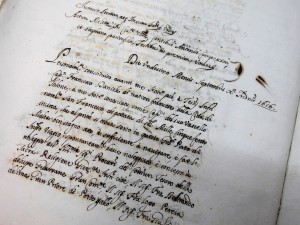 “Since corsairing could render ample returns, people invested in it and received their respective shares from the bounty that the corsairs brought with them after they seized a ship. Investors consisted mainly of businessmen and knights. However, one would also find the Jerosolimitan Nuns of the Sovereign Military Hospitaller Order of St John which were located in St Ursula Street, Valletta, forming part of these investors. Their share was due to them for their role in praying for the safe return of the corsairs.”
“Since corsairing could render ample returns, people invested in it and received their respective shares from the bounty that the corsairs brought with them after they seized a ship. Investors consisted mainly of businessmen and knights. However, one would also find the Jerosolimitan Nuns of the Sovereign Military Hospitaller Order of St John which were located in St Ursula Street, Valletta, forming part of these investors. Their share was due to them for their role in praying for the safe return of the corsairs.”As Dr Abela began to indicate various episodes from the displayed manuscripts, she admitted that she was often very touched by what she read in those pages.
“Obviously when one looks at history in a collective manner, one would say that there was this particular circumstance taking place during that period and that is it. Yet when one looks into these documents and starts reading a deed about an individual life, one starts empathizing with that person and many questions will come to mind. For example, I came upon a deed wherein a priest was selling a slave together with her son to a Genovese merchant on condition that the latter would baptise the child on that same day. The merchant agreed and the deal was made. When you read something like this, how can you help not wonder who this woman was and from where she had come?”
Corsairing was a high risk job but if all went well, those involved could become rich overnight.
“Men craved for the opportunity to become corsairs and at one point, there were so many men leaving their jobs to join corsair ships that the Maltese Universitas requested the King of Spain to restrain this because the island was at a loss with the local workforce.”
“Not all the captured ships delivered the same profits. A galley of the Sultan which would have been filled with riches and fine cloth, would be precious but not without issues and trouble. Other ships would be carrying worthy cargo such as sugar or wheat. Nonetheless, it was the human cargo which was considered the most profitable.”
Captured people could be sold as slaves or held as captives until they were ransomed.
“The whole process for redemption was very complicated. These contracts unravel all this system including how the involved parties went about to assure the best positive outcome from their deal. An agent would be requested to act as an intermediary between one party and the other, taking responsibility to collect a deposit from the captive and then to take him to an agreed destination in order to collect the rest of the money from his relatives and then release him.”
“In April 1558, a slave, Busert Bin Hahmet de Casar concluded the following agreement with his master Giuseppe Baldagno. Busert was transferred to Antonio de Banda from Messina who was a patrone of a ship belonging to Marco Antonio Delixandro, also from Messina. The ship was equipped to undertake a voyage to the Tripolitan fortress of Barbaria. Antonio was to conduct the slave to Tripoli, and from there retrieve 80 gold ducats which was the stipulated price for redemption. This amount was to be remitted either in their value in dinars or in oil, wool or leather goods which the Arabs sold inside the Tripolitan fortress, which goods would be exempt from duty. Busert promised to pay Giuseppe within twenty days of his arrival at the fortress, on condition that the patrone was not to let him disembark unless he received the said payment or its value in goods. Once arrived at destination, the slave would need to make the necessary connection with an intermediary in his own country who would be in a position to acquire the redemption money or goods for him. Once the sum was settled, the slave would become a free man, but if the sum was not paid, he was to return with the same ship and consigned back to his master Giuseppe.”
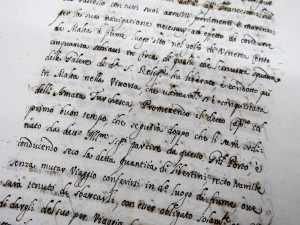 At times, the Grand Master had to issue a safe conduct certificate to enemy ships so that they might transfer the captives to the Tripoli port.
At times, the Grand Master had to issue a safe conduct certificate to enemy ships so that they might transfer the captives to the Tripoli port.“One such case was when Turgut Reis captured the ship Catharinet and took all her load to Djerba in 1548. Following this unfortunate capture for the Christian side, the Knight Augustino Spagno was sent as an envoy to negotiate redemption of the captives and once prices were fixed, a Muslim ship carrying these captives was to sail to the Order’s port in Tripoli.”
Interestingly, although being amid a Holy War against each other, this flourishing trade saw the collaboration and interaction between Christian and Muslim merchants.
“The capture of slaves did not only translate itself into financial rewards but acted also as a means to strengthen commercial ties between the various ethnic subjects of the cross and the crescent. Both Muslim and Christian merchants exploited this cruel reality and at times, this exploitation was so excessive that appeals were made to the local authorities to annul what plaintiffs described as usurious agreements which desperate souls had been forced to endorse in return for their freedom.”
“The Catholic Church strongly prohibited any compensation on loans, whether being related to business or not. Interest was regarded as usury and was not allowed. Often, this situation created shortages of cash money, especially after the Jewish community was expelled from the Maltese Islands in 1492. Nevertheless, there were numerous ways of circumventing this prohibition, such as through the difference quoted in the rate of exchange which would incorporate an agreed rate of interest or by paying the value in other goods.”
Besides ransom agents, there were also those agents who were summoned in order to make arrangements for the purchase of slaves to be delivered to Malta. Gender, age, ethnicity and price were agreed beforehand to eliminate any possible claims for additional payment.
“Although prices of slaves varied considerably, various studies indicate that the average selling price for a slave during the sixtenth century was in the region of 46 scudi. The acquisition of infidel slaves from Tripoli as a commodity for re-sale was one of the most profitable economic activities through which Malta registered a boom in her commerce.”
The arrival of Napoleon in 1798 abolished slavery in Malta and yet from litigation cases found in the Tribunal proceedings, during the early British Period, it is clear that the island’s association with slavery would not be terminated by a simple legislative enactment.
“And yet, back in the eighteenth century, people had already realized that the raiding system was over and that it was not feasible anymore. A new system based on lawful commerce and trade began to emerge; the Pinto stores being evidence of such change.”
(This article was published in the Family Business Supplement issued with The Times of Malta dated 24 February 2017)
Travelogue
Archives
| M | T | W | T | F | S | S |
|---|---|---|---|---|---|---|
| « Jan | ||||||
| 1 | 2 | 3 | 4 | 5 | 6 | 7 |
| 8 | 9 | 10 | 11 | 12 | 13 | 14 |
| 15 | 16 | 17 | 18 | 19 | 20 | 21 |
| 22 | 23 | 24 | 25 | 26 | 27 | 28 |
| 29 | 30 | |||||
Recent Posts
- A MATTER OF FATE
- MALTA’S PREHISTORIC TREASURES
- THE MAGIC IS IN THE DETAIL
- THE SELLING GAME
- NEVER FORGOTTEN
- Ġrajjiet mhux mitmuma – 35 sena mit-Traġedja tal-Patrol Boat C23
- AN UNEXPECTED VISIT
- THE SISTERS OF THE CRIB
Comments
- Pauline Harkins on Novella – Li kieku stajt!
- admin on IL-KARNIVAL TRAĠIKU TAL-1823
- Albert on IL-KARNIVAL TRAĠIKU TAL-1823
- Martin Ratcliffe on Love in the time of war
- admin on 24 SENA ILU: IT-TRAĠEDJA TAL-PATROL BOAT C23